
The Navy Department Library
- Board War Games in the Collection of the Navy Department Library
- British Admiralty Prize Case Books, 1780-1822, in the Navy Department Library
- Commissioning Certificates of US Navy Officers in the Navy Department Library.
- Conference Transcripts of the Allied Combined Chiefs of Staff
- Cruise Books - Ships, Seabees and Training/Education
- Cryptologic Documents in the Navy Department Library
- Dept. of the Navy Documents in Record Groups (RG) at the National Archives & Records Administration (NARA)
- Expand navigation for George Henry Preble Collection George Henry Preble Collection
- German Navy U-boat (Submarine) Headquarters War Logs from World War II
- Guide to United States Naval Administrative Histories of World War II
- Guide to US Naval Administrative Histories of WWII - Appendices
- Irregular Warfare Reading Room
- Expand navigation for Lists of Senior Officers and Civilian Officials of the US Navy Lists of Senior Officers and Civilian Officials of the US Navy
- Naval Air Force, US Atlantic Fleet
- Naval Air Force, US Pacific Fleet
- Amphibious Force, US Atlantic Fleet
- Amphibious Force, US Pacific Fleet
- Atlantic Command, Commander in Chief US
- Commander Sixth Fleet
- Fifth Fleet Commanders
- Expand navigation for Commander First Fleet Commander First Fleet
- Commander in Chief US Allied Forces Southern Europe
- List of Assistant Secretary of the Navy
- Assistant Secretary of the Navy (AIR)
- Assistant Secretary of the Navy (Financial Management)
- Assistant Secretary of the Navy (Installation and Environment)
- Assistant Secretary of the Navy (Manpower and Reserve Affairs)
- Office of Naval Material
- Assistant Secretary of the Navy (Research Development and Acquisition)
- Bureau of Aeronautics
- Bureau of Equipment and Recruitment
- Bureau of Medicine and Surgery
- Bureau of Naval Personnel
- Bureau of Ships
- Bureau of Steam Engineering
- Bureau of Supplies and Accounts
- Bureau of Yards and Docks
- Chief of Chaplains
- Expand navigation for Chiefs of Naval Operations Chiefs of Naval Operations
- Commander in Chief US Naval Forces Europe
- Commander, Naval Education and Training Command.
- Commander Seventh Fleet
- Commanders, Naval Legal Service Command
- Director of Naval Reserve
- Expand navigation for District Commanders District Commanders
- Former Directors
- Gray Eagles
- Japan, Commander US Naval Forces
- Judge Advocate General of the Navy
- Naval Electronic Systems Command Headquarters
- Office of Information
- Secretaries of the Navy
- Under Secretary of the Navy
- Vice Chief of Naval Operations
- Washington Navy Yard, Commandants
- Maritime Research: Selected Institutions With Significant Collections
- Military History and National Security
- Military Service Records and Unit Histories: A Guide to Locating Sources
- Expand navigation for Modern Biographical Files in the Navy Department Library Modern Biographical Files in the Navy Department Library
- Expand navigation for Modern Bios A Modern Bios A
- Abbot, Edward W.
- Abbot, James Lloyd
- Abbott, Clark Tait
- Abbott, William George
- Abbott, Robert Lewis
- Abele, Mannert Lincoln
- Abercrombie, Laurence Allen
- Abercrombie, William Warner
- Abernethy, Elmer Paul
- Abhau, William Conrad
- Abplanalp, Kenneth Clair
- Abrahams, Noble Wayne
- Acker, Frank Clements
- Ackerman, Edward
- Ackiss, Ernest Lee
- Acuff, Jasper Terry
- Adair, Charles
- Adair, Crutchfield
- Adair, Jamie
- Adam, James D.
- Adams, Allen Bond Jr.
- Adams, Benjamin Harrison
- Adams, Carlton Rolla
- Adams, Charles Francis, III
- Adams, Dudley Hale
- Adams, Frank Eugene
- Adams, John Clausel
- Adams, Lenus Franklin
- Adams, Lynn W.
- Adams, Richard Donald
- Adams, Robert Lee
- Adams, Scarritt
- Adams, Spencer Moore
- Adams, Thomas McConnell
- Adams, Woodbury Sanderson
- Adamson, Frank Marshall
- Adamson,Robert Edward Jr
- Adee, Graham Montrose
- Adell, Bruce Byron
- Adell, Cecil Clinton
- Adkins, James Alvin
- Adkins, Joe Dean
- Adrian, Robert Nelson
- Ageton, Arthur Ainsley
- Agnew, Dwight Merle
- Agnew, Henry Follin
- Agnew, Jack
- Agnew, William John Clarke
- Ahern, James Richard
- Ahl, Benjamin Nathaniel
- Ahroon, Thomas Andrew
- Aiau, Harvey Chadwick Kamohoalii
- Ailes, John William, III
- Ainsworth, Herbert Sylvan
- Ainsworth, Walden Lee
- Akers, Frank
- Albers, John Juergen
- Albert, Francis Lee
- Albin, George Waugh
- Albright, Paul Morris
- Albrittain, John Warren
- Alderman, John Clement
- Alderton, Dickson Wellington
- Aldrich, Charles Warren
- Aldrich, Clarence Edward
- Aldrich, Clarence Edward, Jr.
- Aldridge, Eugene Talbert
- Alexander, Joe McKnitt
- Alexander, John Richmond
- Alexander, Marion Snow
- Alexander, Ralph Clonts
- Alexander, Raymond Wellington
- Alexander, Richard Griffiss
- Alexander, Stanley Morton
- Alexander, William Henry
- Alexis, Algert Daniel
- Alford, John Morris
- Alford, Leon Otto
- Alford, Lodwick Houston
- Alford, Zeb Dickey
- Allan, Halle Charles
- Allan, Theodore DeWitt
- Alldredge, Walter Whitmore
- Allegrone, Charles
- Allen, Archer Meredith Ruland
- Allen, Burrell Clinton Jr.
- Allen, Charles Vern
- Allen, Edward Henry
- Allen, Ezra Griffen
- Allen, James Ross
- Allen, Jerome Lee
- Allen, Max Harold
- Allen, Nelson John
- Allen, Robert Addison
- Allen, Roger Hurst
- Allen, Walter Hinds
- Allen, William Young, Jr
- Allendorfer, Harry Carl, Jr.
- Allis, Frederick Ashton
- Allison, Samuel Francis
- Allshouse, Thomas James
- Almgren, Neal
- Alston, Augustus Howard, Jr.
- Altmann, Richard Gustaf
- Alvarez, Everrett, Jr.
- Alvis, Harry James
- Alvis, John Hubbard
- Amberson, Julius Martin
- Ambruster, Stephen Henry
- Amen, William Thomas
- Amme, Carl Henry Jr.
- Ammen, Daniel
- Ames, Lionel Eugene Jr.
- Ammon, William Bronley
- Amsden, William Faulkner
- Ancrum, William
- Anderson, Anton Bennett
- Anderson, Bern
- Anderson, Carl Eric
- Anderson, Charles Carter
- Anderson, Charles Harper Jr.
- Anderson, Clyde Bertram
- Anderson, Edward Abel
- Anderson, Edward Lee
- Anderson, Edwin Alexander
- Anderson, Fernald Philip
- Anderson, Franklin Warren
- Anderson, George W.
- Anderson, Herbert Augustus
- Anderson, Herbert Henry
- Anderson, Jay Stephens
- Anderson, Joseph Bruce
- Anderson, Kenneth Leroy
- Anderson, Norman Oliver
- Anderson, Paul Ramseur
- Anderson, Richard Beatty
- Anderson, Richard Ernest
- Anderson, Robert Harold
- Anderson, Roy Gene
- Anderson, Samuel Clay
- Anderson, Thomas Carlyle
- Anderson, Vernon Leroy
- Anderson, Walter Stratton
- Anderson, William Donald
- Anderson, William Lovett
- Anderson, William Robert
- Anderton, Henry Lafayette Jr.
- Andrews, Adolphus
- Andrews, Burton Howell
- Andrews, Cecil L.
- Andrews, Charles Herbert
- Andrews, Charles Lee Jr.
- Andrews, Clyde Cecil
- Andrews, Edgar Clessie Jr
- Andrews, Frank Arland
- Andrews, John Jr.
- Andrews, Mark Edwin
- Andrews, Richard Stottko
- Andrews, Thomas Loftin Jr.
- Andrews, Walter Edwards
- Andrus, Carlton Leverett
- Angas, William Mack
- Angwin, William Arnold
- Ansel, Walter Charles
- Antle, William Smoot Jr.
- Antoniak, Charles
- Antrim, Archie Arthur
- Antrim, Richard Nott
- Appleby, Charles Albert
- Appleby, Jack Jestiny
- Arbes, James Douglas
- Arbo, Paul Edward
- Arbor, Jesse Walter
- Archambeault, Charles Paul
- Archer, Robert John
- Archer, Stephen Morris
- Arison, Rae Emmett
- Armel, Lyle Oliver
- Armentrout, Erasmus Wilson Jr
- Armstrong, Daniel Williams
- Armstrong, Henry Jacques
- Armstrong, James Houston
- Armstrong, John Hord Jr.
- Armstrong, Parker Broadhurst
- Armstrong, Philip McCutcheson Jr.
- Armstrong, Robert Gordon
- Armstrong, Theodore Hamilton
- Armstrong, Wade Herbert
- Arndt, Ralph William
- Arnett, A.B. Jr.
- Arnold, Henry Albert
- Arnold, Jackson Dominick
- Arnold, James Earl
- Arnold, Malcolm Wesley
- Arnold, Murr E.
- Arnold, Ralph Judd
- Arthur, John Paul
- Arthur, Lionel Alexander
- Arthur, Samuel Hyer
- Ashford, George Woodson
- Ashford, William Henry Jr.
- Ashe, George Bamford
- Ashworth, Frederick L
- Askin, Robert Marshall
- Askins, Herbert R.
- Asserson, William Christian Jr.
- Astor, William Vincent
- Austin, Bernard Lige
- Atkins, James George
- Atkins, Griswold Terry
- Atkins, Nevett Brooke
- Ault, Frank Willis
- Ault, William Bowen
- Austin, Marshall Harlan
- Aurand, Evan Peter
- Austin, Leonard Bynner
- Ausley, Joe Henry, Jr.
- Austin, Frank Hutches, Jr.
- Axene, Dean Lane
- Azer, John Behling
- Ayres, James Edward
- Aymond, John Paul
- Awtrey, Hugh Rainey
- Atkins, Robert Boyer
- Averill, William Renick
- Avery, Bennett Franklin
- Avery, Howard Malcolm
- Atherton, Harry Sheldon
- Austin, Charles Linnell
- Aylward, Theodore Charles
- Atkinson, Roy Charles
- Auken, Wilbur R.
- Expand navigation for Modern Bios B Modern Bios B
- Babbitt, Arlene Keith
- Babione, Robert William
- Bach, Lawrence Earl
- Bache, George Mifflin
- Bachman, Leo Adolph
- Backus, Standish Jr.
- Bacon, Barton Elijah Jr.
- Bacon, Walter Griswold
- Badger, Charles Johnson
- Badger, Harold Raymond
- Badger, Harry Peaslee
- Badger, Oscar Charles
- Badger, Rodney Jenkins
- Badt, Harry Asher
- Baer, Donald G.
- Bagdanovich, Michael Peter
- Baggaley, William
- Bagley, David Harrington
- Bagley, David Worth
- Bagley, Harry Howe
- Bahm, George Henry
- Bailey, Carlos Augustus
- Bailey, Charles Streater
- Bailey, John
- Bailey, Leonard William
- Bailey, Watson Osgood
- Bailey, William Byron
- Bains, George Washington
- Baird, Abraham Lincoln
- Baird, Charles Fitz
- Baird, Leonard James
- Bakenhus, Reuben Edwin
- Baker, Charles Adams
- Baker, Douglas
- Baker, Duncan Scott
- Baker, Felix Locke
- Baker, Guy Evans
- Baker, Harold Davies
- Baker, Harold Edward
- Baker, Robert Leon
- Baker, Robert Nicholson Scott
- Baker, Wilder Dupuy
- Baker, William Bostock
- Bakke, Harlan James
- Bakutis, Fred Edward
- Baldridge, Harry Alexander
- Baldwin, Frank
- Baldwin, Frank Edward
- Baldwin, Robert Bemus
- Baldwin, Robert Hayes Burns
- Balis, Theodore Lawrence
- Ball, Claude Russell
- Ball, George Cornelius Jr.
- Ball, John
- Ballard, Donald Everett
- Ballenger, Felix Pettey
- Ballentine, John Jennings
- Ballinger, John Montgomery
- Ballinger, Richard Robert
- Baltazzi, Harry Warner
- Banister, Alan B.
- Banks, James Oliver
- Bannerman, Graeme
- Bantz, Fred A.
- Barbaro, Joseph Raphael
- Barbee, Albert Ray Jr.
- Barber, Ernest Hayes
- Barbey, Daniel Edward
- Barchet, Stephen George
- Bard, Nathan Wayne
- Bard, Ralph A.
- Bardshar, Frederic Abshire
- Barham, Eugene Alexander
- Barker, Christopher Sylvanus Jr.
- Barker, Edwin Franklin
- Barker, George Nathan
- Barker, Joseph Henry Jr.
- Barker, Nathaniel Charles
- Barlow, Jerry Moulton
- Barlow, John Francis
- Barnaby, Neel Glenn
- Barnaby, Ralph Stanton
- Barnard, Harry Allan Jr.
- Barnard, James Hills, II
- Barner, James Duke
- Barnes, Ernest Richard
- Barnes, Phillip George
- Barnes, Samuel Edward
- Barnes, William Roy
- Barnett, Austin Hill Jr.
- Barney, Greenlief Haskell
- Barnhart, Robert Ernst
- Barnitz, James Wanner
- Barnwell, Joseph Brunson
- Baron, Richard Swan
- Barrett, John Paul Barker
- Barringer, Victor Cameron, Jr.
- Barron, John Powers
- Barrow, William Ballard Jr.
- Barthes, August Aloysius
- Bartlett, Bradford
- Bartlett, Harold Terry
- Bartlett, James Vincent
- Bartlett, John Russell
- Bartlett, Lewis Clark
- Bartol, John Alfred
- Barton, John Kennedy
- Barr, Capers Gamewell Jr.
- Barr, Eric Lloyd Jr.
- Barr, Norman Lee
- Barry, Richard P.
- Barton, Leroy Lewis
- Barton, Wilbur Gardner
- Baskett, Thomas Slack
- Bass, Harry Brinkley
- Bass, Ivan Ernest
- Bass, Raymond Henry
- Bass, Thomas Edward III
- Bassett, Claude Oscar
- Bassett, Frederic Brewster Jr.
- Bassett, Melvin Hughes
- Bassett, Robert V.R., Jr.
- Bassler, Robert Edward
- Bastedo, Paul Henry
- Batchelder, Robert Fred
- Batcheller, Edgar Hadley
- Batchellor, John Kenneth
- Bates, Joseph Clark Jr.
- Bates, Ralph
- Bates, Richard Waller
- Battle, Charlton Eugene, Jr.
- Bauch, Charles Everett
- Bauer, George William
- Bauer, Louis Hallowell
- Bauer, Rudolph Charles
- Bauernschmidt, George William
- Baugh, Dalton Louis, Sr.
- Baughan, Robert Louis, Jr.
- Baughman, Cortlandt Chesterfield
- Baum, George Martin
- Baumberger, Walter Harlen
- Baumeister, John Jr.
- Baumer, Harry William
- Baumgartner, John Peter
- Beam, Carl Eugene
- Bean, Alan Lavern
- Beard, Donald Charles
- Bean, Lawrence Lytton
- Beard, Jefferson Davis
- Beardall, John Reginald
- Beardslee, Lester Anthony
- Beardsley, George Francis
- Beardsley, Henry Leidenheimer
- Bearss, Hiram Iddings
- Beary, Donald Bradford
- Beasley, Charles Black
- Beatty, Frank Edmund
- Beatty, Frank Edmund Jr.
- Beauchamp, Ernest Mortimer
- Beaumont, Arthur Edwaine
- Beaumont, Richard Austin
- Beauregard, Augustin T.
- Beaver, Bud Kearns
- Beaver, Robert Harmon
- Beck, Edward Louis
- Becker, Adolph Ernest Jr.
- Becker, Albert Lilly
- Becker, Alvin Lannard
- Becker, Charles
- Becker, John Joseph
- Becknell, Thomas Leonard Jr.
- Becton, Frederick Julian
- Bedell, Floyd Carson
- Bedell, Porter Fryman
- Beebe, Marshall Ulrich
- Beebe, Robert Park
- Beecher, William Gordon Jr.
- Beggs, Kenneth Gould
- Behan, Austin Carity
- Behm, Edward William
- Behner, Herbert Chauncey
- Behnke, Albert Richard Jr.
- Behrens, Charles Frederick
- Behrens, William Wholsen Jr.
- Behrens, William Wohlsen
- Belcher, Preston Randolph
- Belcher, Roy S. Jr.
- BeLieu, Kenneth E.
- Beling, John Kingsman
- Belin, Peter
- Belknap, George Eugene
- Belknap, Reginald Rowan
- Bell, Clarence Edwin
- Bell, David Bonar
- Bell, Frederick Jackson
- Bell, George Mefford
- Bell, Harman Brown
- Bell, Robert Alexander
- Bellerby, Russell John
- Belles, Ralph Glenn
- Bellinger, Patrick Nieson Lynch
- Bellinger, William C.P. Jr.
- Bernatitus, Ann Agnes
- Benfold, Edward Clyde
- Bengtson, Bengt Norman
- Benham, Andrew Ellicott Kennedy
- Benitez, Rafael Celestino
- Benjes, Anthony Christian Jr.
- Bemis, Harold Medberry
- Bennehoff, Olton Rader
- Benner, Stanley Graves
- Bennett, Andrew Carl
- Bennett, Bradley Frederick
- Bennett, Carter Lowe
- Bennett, Earl Robert
- Bennett, Earle
- Bennett, Edward L
- Bennett, Floyd
- Bennett, Fred G
- Bennett, John Edward
- Bennett, Rawson II
- Bennett, Walter Francis Vincent
- Bennett, Warfield Clay Jr.
- Bennington, John Paige
- Bennion, Mervyn Sharp
- Benson, Francis Wyse
- Benson, Howard Hartwell James
- Benson, Lloyd George
- Benson, Roy Stanley
- Benson, Victor Gordon
- Benson, William Howard
- Bentley, James Alexander
- Bentley, James Calvin
- Benton, Hugh Arthur
- Berg, Winfred Emil
- Bergen, Franklin Steward
- Bergen, John Joseph
- Bergeson, Andrew Harold
- Bergin, Charles Kniese
- Bergin, Daniel Edward
- Bergner, Allen Alfred
- Bergstedt, William Charles
- Bergstrom, Edward William
- Berkheimer, Jack Stanley
- Berkley, Joseph Berzowski
- Berkley, William Leneave
- Bernard, Lawrence George
- Bernet, Howard Cavender
- Bernhard, Alva Douglas
- Berkner, Llloyd Viel
- Berkey, Russell Stanley
- Berley, Ferdinand Victor
- Berndtson, Arthur Henry
- Berner, Warren Kenneth
- Berns, Max Arnold Jr.
- Bernstein, Henry Emil
- Berree, Norman Rahn
- Berrey, Julius M.
- Berrien, Frank Dunn
- Berry, Arthur Frank Jr.
- Berry, Charles Joseph
- Berry, Fred Thomas
- Berry, Fred Thomas, Jr.
- Berry, Frederic Aroyce
- Berry, Howard Burton Jr.
- Berry, Ralph Bryon
- Bertelli, Peter
- Bertelsen, Viggo Christian
- Berthold, Elmer Edward
- Bertholf, Charles Marriner
- Berthrong, Raymond
- Bertoglio, Floyd John
- Bertoglio, Lloyd Webb
- Bertolet, Samuel
- Bertschy, Robert Sylvester
- Berude, John Berthold
- Besbekos, George Angelo
- Beshany, Philip Arthur
- Besson, John Henry Jr.
- Best, William Alexander
- Bethea, James Stephen
- Betts, Sherman Wilcox
- Beuret, John Dougall
- Bevan, George Ronald
- Beveridge, Richard Alexander
- Bewick, James Voigt
- Beyer, Aaron Frederick Jr.
- Beyerly, Irwin Forest
- Bibby, Lowe Hayden
- Biddle, Edward
- Biederman, Karl Joseph
- Bieg, Valentine Nicholas
- Bienia, John Paul
- Bierer, Bion Barnett Jr.
- Bierer, James Shadel
- Bieri, Bernhard Henry
- Bieri, Bernhard H. Jr.
- Biesemeier, Harold
- Bigley, Thomas Joseph
- Bigelow, Elmer Charles
- Biglow, James Otis
- Biggs, Burton Beecher
- Bill, Wells Rood Jr.
- Billingsley, William Devotie
- Binford, Thomas Howell
- Bingham, Donald Cameron
- Bird, Horace Virgil
- Bird, Joseph Lenoir
- Biros, Edmund William
- Blakely, Edward Noe
- Bulkeley, John Duncan
- Burke, Arleigh A
- Burke, Arleigh A.
- Baranowski, Walter Eugene
- Expand navigation for Modern Bios C Modern Bios C
- Cabanillas, Jose M.
- Cabaniss, Robert Wright
- Cabot, Hugh
- Cadwalader, John
- Cady, John Parmelee
- Cafferata, William Francis
- Cagle, Malcolm Winfield
- Cain, James Bernice
- Cain, Mat Murry Jr.
- Caine, Lawrence Ballif Jr.
- Calder, William Edward, III
- Caldwell, Clarence Mills
- Caldwell, Henry Howard
- Caldwell, Rex Smith
- Caldwell, Robert Hugh Jr
- Caldwell, Turner Foster Jr.
- Calhoun, Walter Carson
- Calhoun, William Lowndes
- Calkins, Willard Charles
- Callahan, Cornelius Patrick Jr.
- Callaghan, Daniel Judson
- Callaghan, Robert William
- Callahan-Edward Cooper
- Callahan, Fort Hammond
- Callahan, Joseph William
- Callaghan, William McCombe
- Calver, George Wehnes
- Calvert, Allen Phillip
- Calvert, James Francis
- Calvy, George Lloyd
- Camera, John Alden
- Camera, Robert Snowden
- Cameron, Alan Russel
- Campbell, Duncan Angus
- Campbell, Clarence Henry
- Campbell, George Marvin
- Campbell, George William
- Campbell, Gordon
- Campbell, Herbert John
- Campbell-James-Harry
- Campbell, Norwood Axtell
- Campbell, Robert Lord
- Canada, Robert Owen Jr
- Canaga, Bruce Livingston
- Canaga, Bruce Livingston Jr
- Caney, Lawrence Davidson
- Cantrell, Roy Foster
- Capsas, Cleon Wade
- Carney, Robert Bostwick
- Cantwell, Richard Andrew Jr.
- Canty, Joseph Patrick
- Canty, Thomas John
- Capehart, Wadleigh
- Capell, Delmar Ross
- Caplan, Stanley
- Capodanno, Vincent Robert
- Capone, Lucien Jr.
- Caracciolo, Felix
- Carberry, Deane E.
- Cardoza, Henry
- Carl-Robert-Edgar
- Carlisle, Charles Stuart
- Carlisle, Geoffrey Edmund
- Carlisle, Harold Avery
- Carlson, Albert Leonard
- Carlson, Arnold John
- Carlson, Carl Alexius
- Carlson, Daniel
- Carlson, Frederick Bernard
- Carlson, Frederick Gustaf E.
- Carlson-Milton-Oren
- Carlson, Oscar Ludwig
- Carlson, Richard Pierce
- Carlson, Spencer August
- Carlton, Thomas G
- Carlson, William C
- Carmichael, Daniel Archibald Jr.
- Carmichael, John Harllee Jr.
- Carmick, Edward Seabury
- Carmody-Martin-Doan
- Carnahan, Ralph Herbert
- Carnes, James Robert
- Carney, Francis Joseph
- Carney, Gerald Francis
- Caron, Wayne Maurice
- Carpender, Arthur Schuyler
- Carpenter, Albert Pinson
- Carpenter, Charles Lorain
- Carpenter, Donald F
- Carpenter. Donald Marshall
- Carpenter, Francis
- Carpenter, Gilbert Crowell
- Carpenter, Malcolm Scott
- Carpenter, Stephen Wriston
- Carpenter, William Hubbard
- Carr, Bruce Lewis
- Carr, John H
- Carr, Kenneth Monroe
- Carrington, Royal Casper
- Carrison, Daniel Jordan
- Carroll, Charles Barrett
- Carroll, Chester Edward
- Carroll, Daniel Lynn Jr.
- Carroll, Eugene James Jr
- Carroll, Kent Jean
- Carroll, Penn Leary
- Carroll, Robert Mackin
- Carson, Edward Bruce
- Carson, John Hazard
- Carson, Joseph Malcom
- Carson, Leon Delwin
- Carson, Matthew Vaughan Jr.
- Carson, Virgil Hope
- Carter, Andrew Francis
- Carter, Edward Walter III
- Carter, Francis Miller
- Carter, Grayson Birch
- Carter, James Benham
- Carter, Jesse Hicks
- Carter, Robert Wiman
- Carter, Thomas Jerrell
- Carter, William Joseph
- Carter, Worrall Reed
- Caruthers, Walter Perry
- Caruthers, William Rowell
- Carver, Lamar Peyton
- Cary, Freeman Hamilton
- Case, Clinton DeWayne
- Casey, John Edward
- Casey, Thomas Joseph
- Casey, Vincent Francis
- Cassani, Vincent Louis Jr.
- Cassedy, Hiram
- Cassidy, Herbert Arthur Jr.
- Cassidy, John Joseph Jr.
- Cassel, Charles Moore Jr.
- Cassell, George Louis
- Castelazo, Arthur Harrold
- Castle, Hal Cushman
- Castree, John Fordyce
- Caswell, Gordon Leonard
- Cater, Charles John
- Cates, Clifton B.
- Cates, Clifton Bledsoe Jr.
- Caton, Clifford Edson
- Catlett, William Jackson Jr.
- Caufield, Cecil Thilman
- Cavenagh, Robert William
- Cavendish, Lynn McGraw
- Caveny, Elmer Leonard
- Cavin, Ralph William
- Cease, Lysle Willard
- Cecil, Henry Barton
- Cernan, Eugene Andrew
- Chafee, George Benedict
- Chafee, John Hubbard
- Chaffee, Roger Bruce
- Chamberlin, Douglas Franklin Jr.
- Chamberlin, Leonard Cornelius
- Chambers, George Mitchell
- Chambers, Russell Franklyn
- Chambers, Samuel David Jr.
- Chambers, Thomas Edward
- Chambers, Washington Irving
- Chambers, William
- Chambliss, William Campbell
- Champe, Joseph Elbert
- Champlin, Jackson Selover
- Champlin, Norman David
- Champlin, Stephen
- Chandler, Alvin Duke
- Chandler, Ralph Stewart
- Chandler, Robert Alexander
- Chandler, Theodore Edson
- Chanler, Hubert Winthrop
- Chapman, Donald D.
- Chapman, Harold Julius
- Chapman, Joseph Ellsworth
- Chapman, William Harold
- Chappell, Lucius Henry
- Chapple, Wreford Goss
- Charbonnet, Pierre Numa Jr.
- Charette, William Richard
- Charles, Robert Gene
- Charneco, Carlos Mario
- Chase, Earl Richardson
- Chase, Jay Valentine
- Chase, Jehu V.
- Chase, John Dawson
- Cheatham, Benjamin B.
- Cheatham, Joseph Johnston
- Cheffey, John Howard
- Chenault, Frederic Archibald
- Chenault, Oran Ward
- Cheney, Grace
- Cheney, Wilbur Haines Jr.
- Chew, John James
- Chew, John Louis
- Chewning, Robert Wills
- Childers, Kenan Clark Jr.
- Chiles, Griffin
- Chillingworth, Charles Frederick Jr.
- Chilton, Arthur Bounds Jr.
- Chilton, William Pierce
- Chimiak, Walter
- Chipman, Briscoe
- Chittenden, John Lester
- Chourre Emile
- Christensen, Ernest E.
- Christensen, Waldeman Nichlous
- Christensen, Wayne John
- Christensen, William Harold
- Christian, Kemp Catlett
- Christiansen, Arnold Robert
- Christiansen, George Martin
- Christiansen, John Saabye
- Christie, Ralph Waldo
- Christie, Warren Byron
- Christopher, Thomas Aloysius
- Christy, Harley Hannibal
- Chung-Hoon, Gordon Paiea
- Church, Albert Thomas Jr.
- Claggett, Bladen Dulany
- Claiborne, Henri De Balathier
- Clark, Allen LeRoy
- Clark, Asa Allan III
- Clark, Carlton Howard
- Clark, Charles Edgar
- Clark, Clarence Floyd
- Clark, Frank Hodges
- Clark, Grover Vincent
- Clark, Henry Garner
- Clark, James Seerley
- Clark, Jeane R
- Clark, John Alfred
- Clark, John Edward
- Clark, John Pascoe
- Clark, Joseph James
- Clark, Morris Young
- Clark, Richard Godfrey
- Clark, Robert Nicholson
- Clark, Sam Echols
- Clarke, Paul Walker
- Clarke, Ralph Sperry
- Clarke, Walter Edward
- Clarkson, Arthur Alexander
- Clarkson, James Stroud
- Clausner, Edward Jr.
- Clay, Donald Noble
- Clay, James Powell
- Clay, Mark Wellington
- Claytor, Spry Owen
- Claytor, William Graham, Jr.
- Cleaves, Alfred Sargent
- Cleborne, John Cuthbert
- Clegg, Courtney Gee
- Clegg, Glenn William
- Cleland, Cook
- Clementson, Merrill Kinsell
- Clexton, Edward William
- Cline, John Burnett
- Clinton, Jack William
- Close, Burdette Eugene
- Close, Forrest
- Close, Robert Hamilton
- Cloukey, Malcolm Mather
- Clover, Richardson
- Coad, Richard Joseph
- Coale, Griffith
- Coates, Leonidas Dixon, Jr.
- Coats, Robert Charles
- Cobb, Calvin Hayes
- Cobb, James Outterson
- Coe, James Wiggins
- Connally, John Bowden, Jr.
- Cobean, Warren Richardson Jr.
- Coburn, Ralph G.
- Cochrane, Joe Brice
- Cochran, Thomas
- Cocke, Herbert Claiborne
- Cockell, William Arthur
- Coddington, James Arthur
- Coe, Benjamin
- Coe, Charles Frederick
- Coffin, Albert Peyton
- Coffin, Clarence Emmett
- Coffin, Harry Nelson
- Coffman, Dewitt
- Cogswell, Francis
- Cogswell, James Kelsey
- Cogswell, Wilson Patterson
- Cohen, Marion
- Cohen, Marshall
- Coil, Emory Wilbur
- Cokely, Harold Jay
- Coker, Charles Walter
- Colahan, Charles Edward
- Colbert, Richard G.
- Cole, Allyn Jr.
- Cole, Cyrus Churchill
- Cole, Cyrus Willard
- Colee, Henry Charles Jr.
- Cole, Otis Robert Jr.
- Cole, Shelby Olaf
- Coley, Charles Coston
- Coley, Vernon Jackson Jr.
- Colleran, Gerald Francis
- Collins, Dale Edmond
- Collins, Pierre Dey
- Clifton, Joseph Clinton
- Coleman, William Bryan
- Christman, Thomas Jackson
- Christmas, Walter Frederick
- Clark, Cecil
- Church, William Campbell Gibson
- Clark, Thurston Booth
- Church, Spencer Chapin
- Chrisman, Allan Simpson
- Cole, Darrell Samuel
- Campbell, Clifford Morgan
- Campbell, Colin
- Campbell, Earnest Goodrich
- Camp, Floyd Charles
- Cassady, John Howard
- Coleman, Walter Dan
- Cole, William Marchant
- Collins, Howard Lyman
- Colligan, Thomas Richard
- Colestock, Edward Emerson
- Cohn, James Edward
- Cluverius, Wat Tyler
- Campbell, Edward Hale
- Caperton, William Banks
- Cassard, Paul
- Champion, Carleton Cole, Jr.
- Chandler, Lloyd Horwitz
- Chantry, Allan J. Jr.
- Challenger, Harold Lincoln
- Chapline, Vance Duncan
- Chappell, John Robert
- DeCourcesses, Godfrey Chevalier
- Child, Warren Gerald
- Church, Gaylord
- Clark, Alto Benjamin
- Clarke, Horace Donald
- Clayton, Marvin Clyde
- Cloughley, Sterling
- Chase, Nathan Brown
- Collett, John Austin
- Clancy, Albert Harrison, Jr.
- Converse, Adelbert Frink
- Cornwell, Delbert Strother
- Cowhill, William Joseph
- Expand navigation for Modern Bios D Modern Bios D
- Dabney, Thomas Bullard
- Dacey, John Elmer
- Dachs, Lukas Victor
- Dalton, John Howard
- Daly, Daniel Joseph
- Danzig, Richard Jeffrey
- DeCamp, Louis Earle
- Decker, Arthur Turn
- Decker, Benton Weaver
- Dedman, Tyler Freeland
- Dedrick, Walter
- Deegan, Joseph Francis
- Deegan, Joseph Francis Jr.
- Deem, Joseph Mason
- Deen, Harvard Franklin
- Dees, Randal Euesta
- de Florez, Luis
- DeFoney, Clinton Githens
- DeFord, Clifford Conrad
- Defrees, Joseph Rollie
- Defrees, Joseph Rollie Jr.
- Deibler, William Henry Jr.
- DeKay, Charles Gordon
- DeKrafft, John Charles Philip
- Delahanty, Frank Patrick
- Delaney, Henry Raymond
- DeLaney, John Francis
- Delano, Victor
- DeLany, Walter Stanley
- DeLargy, John Martin
- Delezene, James Robert
- Dell, Thomas Medairy, Jr.
- DeLong, Edward Grover
- DeLong, Henry Clay
- Demarest, Harold Raymond
- Demetropolis, George
- Demmler, Charles Frederick
- Dempsey, James Charles
- Denbo, Robert Wayne
- Denebrink, Francis Compton
- Denegre, Thomas Bayne Jr.
- Denfeld, Louis Emil
- Denneen, John Paul
- Dennett, Erle Van Emburgh
- Dennis, Jefferson Rice
- Dennison, Robert Lee
- Denton, Jeremiah Andrew Jr.
- Denton, William Thomas
- de Poix, Vincent Paul
- Deragon, William Nolin
- DeTar, John Leslie
- Dettmann, Frank Carl Louis
- Detweiler, Louis Mitchell
- Detzer, August J Jr.
- Deutermann, Harold Thomas
- Deutermann, William Vincent
- Dew, Carlos Jr.
- Dew, Irvin Lowell
- Dewert, Richard
- Dewey, William Harold
- Dewitt, John Carroll
- Dewitt, Nellie Jane
- DeWolf, Maurice Mortimer
- DeVane, John Murphy Jr.
- DeVico, Anthony James
- DeVos, Paul Louis
- Deyo, Morton Lyndholm
- Dexter, Edwin Boardman
- Dibrell, Aquilla Gibbs Jr.
- Dichman, Grattan Colley
- Dick, John Henry
- Dickens, Paul Frederick Jr.
- Dickeman, Charles Theodore
- Dickerson, Vincent Manford
- Dickey, Fred Clinton
- Dickey, Willie Mills
- Dickinson, Dwight Jr.
- Dickinson, Everett Homer
- Dickinson, George Wallace
- Dickinson, Milton Carey
- Dickson, Edward Andrew
- Dickson, Harlan Rockey
- Dickson, John Paul
- Diehl, Walter Stuart
- Diekhoff, Arold Harry
- Dierdorff, Ross Ainsworth
- Dierman, Frederick George
- Doyle, James H.
- Expand navigation for Modern Bios E Modern Bios E
- Eagle, Carlton Robert Jr.
- Earle, Otis John
- Earle, Ralph
- Earle, Ralph Jr.
- Early, Julius C Jr.
- Early, Paul John
- Eason, Van Vernon Jr
- Easterling, Henry McCloy
- Eaton, Melville Edwin
- Easton, William Thomas
- Eastwold, Earl Russell
- Eaton, William Guy
- Eberhart-John-Jacob
- Eberhard, Arthur Charles
- Eberle, Edward Walter
- Ebersole, John Henry
- Ebert, Hilan
- Ebert, Walter Gale
- Eccles, Henry, Effingham
- Eckberg, Herbert Frederic
- Eckberg, Walter Theodore
- Eckhoff, Frederick John
- Eckelmeyer, Edward Herman Jr.
- Eddy, Daniel Thomas
- Eddy, Thomas Roderick
- Ede, Shakeeb
- Edgar, Campbell Dallas
- Edmands, Ernest John
- Edsall, Warner R.
- Edson, Merritt A
- Edson, Stephen Reuben
- Edwards, David Shelton Jr.
- Edwards, Hal Knox
- Edwards, Heywood Lane
- Edwards, Irwin Griffith
- Edwards, John Ellis
- Edwards, John Quincy III
- Edwards, Raymond Dorsey
- Edwards, Steven Hamilton
- Edwards, Walter Atlee
- Efird, Terril Alexander
- Eggert, Ernest Frederick
- Eggers, Fremont Baldwin
- Eisenbach, Charles Robert
- Eisenhart, George Norman
- Ekvall, Leslie David
- Ekas, Claude Philip Jr.
- Eldridge, John Jr.
- Eldridge, Robert Louis
- Elfelt, James Sidle
- Eller, Donald Temple
- Eller, James Borden
- Elliott, Edward Charles
- Elliott, James Brona Jr.
- Elliott, James Meacham
- Ellis, Charles John
- Ellis, George Fitzallen
- Ellis, Hayne
- Ellis, Herbert Aloysius
- Ellis, James William
- Ellis, Paul Bush
- Ellis, Robert Beaman
- Ellis, Walter John
- Ellis, William Anthony
- Ellis, William David
- Ellis, William Edward
- Ellis, William Harold
- Ellison, Harold J
- Ellison, Stanley Edgar
- Ellison, Thomas Ballard
- Elliott, Ralph Earle Jr
- Elliott, Robert Waite
- Ellsberg, Edward
- Ellsworth, Ernest Bradford Jr.
- Ellyson, Theodore Gordon
- Elpers, William Wendell
- Elsasser, Leo Joseph
- Ely, Don Lelo
- Embree, Ralph Arnold
- Emery, George W.
- Emrick-Paul-E
- Emory, Campbell Dallas
- Engelman, William LeRoy
- Engen, Donald Davenport
- Enger, Walter Melvin
- Engle, Paul Raymond
- Eaton, William
- Esslinger, Robert John
- Estabrook, William Sears Jr.
- Esterly, Marcus H
- Etter, Harry Stough
- Etter, James Henry Jr.
- Eubank, Gerald Abner
- Evans, Donald Sidley
- Evans, Earl Foster
- Evans, Charles Leo Glandore
- Evans, Ernest Edwin
- Evans, Francis Thomas
- Evans, Frank Edgar
- Evans, Franck Taylor
- Evans, Griffith Conrad Jr.
- Evans, Myron Thomas
- Evans, Ronald Ellwin
- Evans, Stuart James
- Evans, William Ashby
- Evans, William Augustus
- Evans, William Robinson
- Evenson, Marvin Pabodie
- Everett, Gordon Stafford
- Everett, Robert James
- Evers, Adelbert Ray
- Eversole-Frederick-Lowell
- Eversole, John Thomas
- Ewen, Edward Coyle
- Ewing, John Lawrence
- Ewoldt, Leonard Emil
- Eytchison, Ronald M
- Eynon, Everett
- Eyer-Alfred-W
- Expand navigation for Modern Bios F Modern Bios F
- Fairbanks, Douglas Elton, Jr.
- Fechteler, William Morrow
- Fellers, William Machen
- Fellowes, Frederick Gale Jr.
- Fellows, Carl Morton
- Fellows, John Benjamin Jr.
- Felter, John Francis
- Fenn, Herbert Keeney
- Fenner, Edward Blaine
- Fenton, Charles Rudolph
- Fenwick, Joseph Eugene
- Ferguson, Charles Lee
- Ferguson, George William
- Ferguson, Glover Trenholm
- Ferguson, James Dugue
- Ferguson, John Alexander
- Ferrante, John Michael
- Ferrara, Maurice
- Fernald, James Merrill
- Ferris, Floyd Franklin
- Ferris, James
- Fessenden, Reginald Aubrey
- Ferwerda, Thomas
- Fiala, Reid Puryear
- Fick, Harold Foster
- Fidel, John Anthony
- Field, Jennings Pemble Jr.
- Field, Robert Bunton
- Fifield, John Gordon
- Fielding, Charles Frederick
- Fielding, Teddy Roosevelt
- Fillebrown, Thomas Scott
- Finch, Joseph Warren Jr.
- Findley, Lloyd Gordon
- Fine, Stanley Sidney
- Fink, Carl Kenneth
- Finley, Miles Rush Jr.
- Finn, John William
- Finneran, John Glennon
- Finney, Earl Peck
- Fiorini, Elmer Bernard
- Fischer, George Eckerson
- Fischer, Harry Frederick Jr.
- Fischler, Peter Kalsch
- Fisher, Allan Jack
- Fisher, Alton Kindt
- Fisher, Alvan
- Fisher, John Richard
- Fisher, Lee Wilson
- Fitch, Henry Winslow
- Fitzgerald, Charles Tuckerman
- Fitzgerald, John Allison
- Fitzgerald, William Francis
- Fitzgibbon, John Edmondson
- Fitzhugh, Mayo McGill
- Fitzsimmons, John Patrick
- Flaherty, Michael F. D.
- Flatley, James H.
- Fleming, Morton K.
- Floyd, William Orrin
- Fluckey, Eugene Bennett
- Fluegel, Fred Charles
- Flynn, John Francis
- Flynn, Joseph Edward
- Flynn, Russell Francis
- Flynn, Thomas Joseph
- Foertner, John Frederick
- Fogel, Roland Harwood
- Foley, Francis Drake
- Foley, Harry John Patrick
- Foley, Joseph Ferrall
- Foley, Paul Jr.
- Foley, Robert Joseph
- Foley, Sylvester Robert
- Folk, Winston Pilcher
- Folsom, Parker Lowell
- Foote, John Storrs
- Foott, George Wade
- Ford, Gerald R.
- Ford, John
- Ford, Warren Woodrow
- Foreman, Robert Payton
- Forest, Francis Xavier
- Forman, Robert Noel
- Formoe, Clarence Melvin
- Franke, William Birrell
- Fagan, Edward Mallon
- Forbes, Bernard Brown
- Fair, John Warren
- Fickling, Evan Edward
- Field, Benjamin Prince Jr.
- Field, Wells Laflin
- Fink, Beauford Wallace
- Firth, Maxim William
- Fischer, Charles Fink
- Fisher, William Gooding
- Fish, Howell Church
- Fiske, Bradley Allen
- Fiske, Leon Sangster
- Fitch, Aubrey Wray
- Fitch, Howard Wesley
- Fitx, Harold Carlton
- Fitzsimmons, Andrew Madison Raplee
- Flannery, John Leo
- Fleck, Bernard Arnold
- Fleming, Edward Sanger
- Fletcher, Frank Friday
- Fligg, Claude M.
- Floberg, John Forrest
- Forrest, Gaylord Theodore
- Forsander, John Philip
- Forster, Edward William
- Foss, Joseph Jacob
- Foster, Edwin Dorsey
- Foulk, Edwin DeWitt
- Foulkes, William O.
- Fagan, John Fischer Jr.
- Fahle, Robert Schley
- Fahrion, Frank George
- Fahrney, Delmer S.
- Fahy, Edward Joseph
- Fielder, Charles William
- Fitzpatrick, Francis John
- Fitz-Patrick, Joseph Paul
- Flaherty, Arthur Ingoldsby
- Flanigan, Howard Adams
- Fairchild, Milton Duncan
- Faires, Carl Franklin, Jr.
- Fairfax, Eugene George
- Fair, Robert Eli
- Fickenscher, Edward Robinson, Jr.
- Fleck, Francis Edward, Jr.
- Fleming, Allan Foster
- Fleming, Morton Klyne, Jr.
- Fleming, Patrick Dawson
- Flenniken, Clifton Wharton, Jr.
- Fletcher, Francis O'Conner, Jr.
- Fletcher, William Bartlett
- Ford, Walter Chilcott
- Fortune, William Charles
- Foster, Clifford Smith Jr.
- Foster, Edward Lee
- Foster, Festus Finley
- Foster, John Golden, Jr.
- Foster, John Lee
- Fairfield, Arthur Philip
- Flachsenhar, John Jay
- Expand navigation for Modern Bios G Modern Bios G
- Gabbert, John S. C.
- Gaddis, Seeman
- Gaffney, John Jerome
- Gaillard, William Edward
- Gainard, Joseph A.
- Gaines, Oliver Wallace
- Gaines, Richard Kenna
- Galantin, Ignatius Joseph
- Garcia, Edmund E.
- Garrett, III H. Lawrence
- Gates, Jr. Thomas Sovereign
- Gay, George Henry
- Geiselman, Ellis Hugh
- Ghormley, Robert Lee
- Giffen, Robert Carlisle
- Gingrich, John E.
- Godson, William Howard, Jr.
- Godinez, Marcos Antonio
- Godfrey, Earl Francis
- Garrison, Philip Eugene
- Gartenlaub, Charles
- Gavin, Arthur
- Gaw, Benjamin Donald
- Geib, Philip Oldham
- Geisinger, David
- Genders, Richard Atherstone
- Expand navigation for Modern Bios H Modern Bios H
- Expand navigation for Modern Bios I Modern Bios I
- Expand navigation for Modern Bios J Modern Bios J
- Expand navigation for Modern Bios K Modern Bios K
- Expand navigation for Modern Bios L Modern Bios L
- Expand navigation for Modern Bios M Modern Bios M
- Mabus, Raymond Edwin, Jr.
- Martin, Charles Franklin
- McCann, Allan R.
- McClusky, Clarence Wade
- McGonagle, William Loren
- McMorris, Charles H.
- Michaelis, Frederick
- Miles, Milton E.
- Mitscher, Marc Andrew
- Moffett, Willam Adger, Sr.
- Moffett, William Adger, Jr.
- Momsen, Charles B.
- Montgomery, Alfred Eugene
- Moorer, Thomas Hinman
- Morison, Samuel Eliot
- Mullinnix, Henry Maston
- Murray, Albert Ketcham
- Mustin, Lloyd M.
- Mendenhall, William Kavanaugh Jr.
- Expand navigation for Modern Bios N Modern Bios N
- Expand navigation for Modern Bios O Modern Bios O
- Expand navigation for Modern Bios P Modern Bios P
- Expand navigation for Modern Bios Q Modern Bios Q
- Expand navigation for Modern Bios R Modern Bios R
- Expand navigation for Modern Bios S Modern Bios S
- Sanchez, Henry Gabriel
- Scott, Norman
- Semmes, Raphael
- Sherman, Frederick C.
- Sims, William Sowden
- Sowell, Jesse Clyburn
- Spencer, Richard V.
- Sprague, Clifton Albert Frederick
- Sprague, Thomas L.
- Spruance, Raymond Ames
- Stackley, Sean Gerard Joseph
- Stockdale, James Bond
- Struble, Arthur Dewey
- Sullivan, John Lawrence
- Expand navigation for Modern Bios T Modern Bios T
- Expand navigation for Modern Bios U Modern Bios U
- Uehlinger, Archibald Emil
- Uhrenholdt, Andrew Curtis
- Ulen, Francis Graeme
- Underhill, Edward Griffin
- Underhill, James L.
- Underwood, Herbert Whitwell
- Ungar, J. Stephen
- Unmacht, George Paul
- Unruh, H. Kirk
- Upham, Frank Brooks
- Urban, Kenneth Lee
- Urbanczyk, Louis Thaddeus, Jr.
- Urquhart, James Burwell, Jr.
- Ustick, Theodore Montanye
- Utter, Harmon Tischer
- Expand navigation for Modern Bios V Modern Bios V
- Valencia, Eugene Anthony
- Van Landingham, J. Philip
- Van Mater, Blinn
- Van Meter, Karl Schlegel
- Van Metre, Merle
- Van Metre, Thaddeus Johnson
- Van Ness, Harper Elliott
- Van Orden, Merton, Dick
- Van Swearingen, Earl Kendall
- Van Valkenburgh, Franklin
- Van Zandt, James Edward
- Vannoy, Frank Wilson
- VanPeenen, Hubert John
- Vardaman, James Kimble, Jr.
- Varian, Donald Cord
- Vasey, Lloyd Roland
- Vaughan, James John
- Vaughan, Paul
- Vaughn, Robert James
- Veasey, Alexander Craig
- Veazey, David Julian
- Vecchione, Felix Salvatore
- Veeder, William Schuetze
- Vejtasa, Stanley Winfield
- Veline, Carl Ashton
- Vellis, Demetrius John
- Venlet, David J.
- Verhoye, Harry James
- Vernou, Walter Newhall
- Vesole, Kay Kopl
- Vest, John Pinckney Wheeler
- Veth, Kenneth LeRoy
- Vickrey, William Clyde, Jr.
- Vieweg, Walter Victor Rudolph
- Villines, William McKinley, Jr.
- Vincent, Walter Michael
- Vincent, Warren Crist
- Vinock, Eli
- Violett, Quentell
- Virden, Frank
- Virtue, Clark Wakeman
- Visser, Richard Gerben
- Vita, Harold Emanuel
- Vitale, Michael C.
- Vittek, Albert William
- Vitucci, Vito Louis
- Voegeli, Clarence Earl
- Voelker, George E.
- Voetsch, Stephen S.
- Vogan, Guy Sedgwick
- Voge, Richard George
- Vogel, Joseph
- Vogeley, Theodore Robert
- Vogelgesang, Carl Theodore
- Vogt, Larry Gene
- Voils, Roy Cramer
- Von Dreele, William Henry
- Von Heimburg, Ernest Herman
- Von Kleeck, Ernest Saint Clair, Jr.
- Von Weller, George Schoen
- Voorhies , James Franklin
- Voris, Frank Burkhart
- Vorse, Albert Ogden, Jr.
- Vose, James Everett, Jr.
- Vose, William Cecil
- Vosseller, Aurelius Bartlett
- Vossler, Francis Alfred L.
- Vraciu, Alexander
- Expand navigation for Modern Bios W Modern Bios W
- Modern Bios X
- Expand navigation for Modern Bios Y Modern Bios Y
- Yancey, Evan White
- Yankey, William Rose
- Yarbrough, Oscar D.
- Yarnell, Harry Ervin
- Yates, Charles Moulding
- Yates, Earl Preston
- Yates, Marion Twitty
- Yavorsky, Joseph Thomas
- Yeager, Howard A.
- Yeomans, Elmer E.
- Yesensky, Albert Samuel
- Yon, Joseph Langham
- Yoran, George Francis
- Young, Andrew Lee, Jr.
- Young, Cassin
- Young, Charles B.
- Young, David Bryan
- Young, David Bryan, Jr.
- Young, Howard Leyland
- Young, Leo C.
- Young, Lloyd Verne
- Young, Mark A.
- Young, Rufus Calhoun
- Young, Robert Todd
- Young, William Brent
- Youngblood, Curtis Tillman
- Youngkin, Carl Kenneth
- Youtz, Ellis Gardiner
- Expand navigation for Modern Bios Z Modern Bios Z
- Zabilsky, John
- Zabriskie, Jr. David
- Zacharias, Ellis Mark
- Zahm, John Crawford
- Zech, Jr. Lando William
- Zehner, John Adolphus
- Zeigler, Samuel Jacob
- Zelibor, Thomas E.
- Zellars, Thomas Edward
- Zemmer, Harold Maurice
- Zern, Richard Dewey
- Ziegemeier, Henry, Joseph
- Zilmer, Richard C.
- Zimble, James Allen
- Zimermann, Richard Galt
- Zimet, Stanford Frederick
- Zimmerli, Rupert Meyrick
- Zimmerman, Max Edward
- Zimmerman, Milton Abraham
- Zimmerman, Nelson Daniel
- Zimmerman, Walter Earnest
- Zimmermann, Edwin Julius Jr.
- Ziroli, Humbert William
- Zitzewitz, Herbert Carl
- Zobel, William Alexander
- Zola, Stanley Peter
- Zondorak, Charles Joseph
- Zornow, Gerard, Philip
- Zurmuehlen, Gerald Dale
- Zumwalt, Elmo Russell Jr.
- Zundell, Joseph L.
- Expand navigation for Modern Bios A Modern Bios A
- Naval Training/Education Yearbooks
- Navy Personnel: A Research Guide
- Navy-Themed Sheet Music
- Newsletters in the Navy Department Library
- Organizational Charts and Directories of the US Navy
- Expand navigation for Postal Cover Collection in the Navy Department Library Postal Cover Collection in the Navy Department Library
- Ship Postal Covers Finding Aid
- US Navy General Order No. 74 of 27 June 1908 establishing ship post offices
- Ship-Plane Mail; Delivery of at Sea
- 7th Fleet Mail
- Expand navigation for Examples of Ship Postal Covers in the Navy Department Library Examples of Ship Postal Covers in the Navy Department Library
- USS Abraham Lincoln (SSBN-602) 16 Nov 1971
- USS Alstede (AF-48) 4 July 1962
- USS Amphion (AR-13) 27 Oct 1960
- USS Anchorage (LSD-36) 12 Jan 1978
- USS Anderson (DD-411) 27 Oct 1939
- USS Enterprise (CVA(N)-65) 16 Aug 1962
- USS Enterprise (CVA(N)-65) 27 Oct 1962
- USS Enterprise (CVA(N)-65) 22 Sep 1964
- USS Enterprise (CVA(N)-65) 2 Oct 1964
- USS Enterprise (CVAN-65) 5th Anniversary 25 Nov 1966
- USS Enterprise (CVAN-65) 10th Anniversary 25 Nov 1971
- USS Enterprise (CVA(N)-65) 6 Jan 1972
- USS Enterprise (CVN-65) 22 Aug 1978
- USS Constitution The War of 1812 Commemoration Stamp
- Antarctic Postal Procedures
- United States Navy Fleet Post Office, New York Souvenir Book
- United States Navy Fleet Post Office, San Francisco Souvenir Book
- Rodgers Family Collection at the Navy Department Library
- Expand navigation for Shipbuilding Contracts Shipbuilding Contracts
- Index to Vol. 13
- Index to Vol. 14
- Index to Vol. 15
- Index to Vol. 16 Pt. 1
- Index to Vol. 16 Pt. 2
- Index to Vol. 18 Pt. 1
- Index to Vol. 18 Pt. 2
- Index to Vol. 19
- Index to Vol. 20
- Index to Vol. 21
- Index to Vol. 22
- Index to Vol. 23
- Index to Vol. 24
- Index to Vol. A to B
- Index to Vol. A to C
- Index to Vol. B to Ce
- Index to Vol. Ch to D
- Index to Vol. D to E
- Index to Vol. D to M
- Index to Vol. F to Ge
- Index to Vol. Gi to K
- Index to Vol. L to M
- Index to Vol. N to Q
- Index to Vol. N to W
- Index to Vol. R to Sm
- Index to Vol. So to T
- Index to Vol. U to Z
- Contract for the Construction of Indianapolis Light Cruiser No. 35
- US Navy Shipbuilding Contracts in the Navy Department Library
- Expand navigation for Source Guide Entry by State Source Guide Entry by State
- Expand navigation for Alabama Alabama
- Expand navigation for California California
- California Historical Society
- California Polytechnic University
- Hoover Institution of War, Revolution, and Peace
- The Huntington Library, Art Collections, and Botanical Gardens
- National Archives and Records Administration, Pacific Region
- Naval Air Warfare Center Weapons Division
- Naval Facilities Engineering Command Historian's Office
- Naval Postgraduate School
- Oakland Public Library
- Stanford University Libraries
- University of California, Berkeley
- University of California, Los Angeles
- University of California, San Diego
- University of Southern California
- Vallejo Naval and Historic Museum
- National Archives and Records Administration, Pacific Region
- Expand navigation for Colorado Colorado
- Expand navigation for Connecticut Connecticut
- Expand navigation for Delaware Delaware
- Expand navigation for District of Columbia District of Columbia
- Archives of American Art
- Bureau of Medicine and Surgery
- Catholic University of America
- Georgetown University
- Library of Congress
- Marine Corps History and Museums Division
- National Aeronautics and Space Administration
- National Air and Space Museum
- National Archives and Records Administration
- National Museum of American History
- National Society of the Daughters of the American Revolution
- Naval History and Heritage Command
- Naval Observatory
- Naval Research Laboratory
- Smithsonian Institution Archives
- Expand navigation for Florida Florida
- Expand navigation for Georgia Georgia
- Expand navigation for Hawaii Hawaii
- Expand navigation for Illinois Illinois
- Expand navigation for Indiana Indiana
- Expand navigation for Iowa Iowa
- Expand navigation for Kansas Kansas
- Expand navigation for Kentucky Kentucky
- Expand navigation for Louisiana Louisiana
- Expand navigation for Maine Maine
- Expand navigation for Maryland Maryland
- Applied Physics Laboratory
- Carderock Division, Naval Surface Warfare Center
- Chesapeake Bay Maritime Museum
- Fort McHenry National Monument
- Johns Hopkins University
- Maryland Historical Society
- Maryland State Archives
- National Archives and Records Administration
- National Library of Medicine
- Steamship Historical Society Collection
- University of Maryland
- U.S. Naval Academy
- U.S. Naval Academy Museum
- Expand navigation for Massachusetts Massachusetts
- American Antiquarian Society
- Andover Historical Society
- Beverly Historical Society and Museum
- Boston Athenaeum
- Boston Public Library
- Boston University
- College of the Holy Cross
- Commonwealth of Massachusetts, Archives Division
- Concord Free Public Library
- Harvard University
- Harvard University Archives
- Harvard University, Business School
- Harvard University, Gray Herbarium
- Haverhill Public Library
- John F. Kennedy Library
- Longfellow National Historic Site
- Marblehead Historical Society
- The Massachusetts Historical Society
- Nantucket Historical Association
- New England Historic Genealogical Society
- Old Dartmouth Historical Society and New Bedford Whaling Museum
- Peabody Essex Museum
- Radcliffe Institute for Advanced Study
- Smith College
- Tufts University
- Expand navigation for Michigan Michigan
- Expand navigation for Minnesota Minnesota
- Expand navigation for Mississippi Mississippi
- Expand navigation for Missouri Missouri
- Expand navigation for Nebraska Nebraska
- Expand navigation for New Hampshire New Hampshire
- Expand navigation for New Jersey New Jersey
- Expand navigation for New York New York
- American Jewish Historical Society
- Cornell University
- The Explorers Club
- Museum of Modern Art
- Franklin D. Roosevelt Library
- New-York Historical Society
- New York State Library
- The New York Public Library
- The Morgan Library
- University of Rochester
- Syracuse University
- Buffalo and Erie County Historical Society
- Chemung County Historical Society
- Washington's Headquarters State Historic Site
- American Museum of Natural History
- Rensselaer Polytechnic Institute
- New York State Historical Association
- U.S. Military Academy
- Columbia University
- Expand navigation for North Carolina North Carolina
- Expand navigation for Ohio Ohio
- Expand navigation for Oklahoma Oklahoma
- Expand navigation for Oregon Oregon
- Expand navigation for Pennsylvania Pennsylvania
- Academy of Natural Sciences
- American Philosophical Society
- American Swedish Historical Museum
- Carnegie Library of Pittsburgh
- Dickinson College
- Erie County Historical Society
- Franklin and Marshall College
- The Franklin Institute
- Haverford College
- Historical Society of Pennsylvania
- Independence Seaport Museum
- Pennsylvania Historical and Museum Commission
- Pennsylvania State University
- Philadelphia City Archives
- University of Pittsburgh
- U.S. Army Military History Institute
- Expand navigation for Rhode Island Rhode Island
- Expand navigation for South Carolina South Carolina
- Expand navigation for Tennessee Tennessee
- Expand navigation for Texas Texas
- Expand navigation for Utah Utah
- Expand navigation for Vermont Vermont
- Expand navigation for Virginia Virginia
- Expand navigation for Washington Washington
- Expand navigation for West Virginia West Virginia
- Expand navigation for Wisconsin Wisconsin
- Expand navigation for Wyoming Wyoming
- Terrorism
- Terrorism: A Navy Department Library Research Guide
- UFO Research Guide
- U.S. Military History and National Security: A Research Guide
- US Naval Administrative Histories of World War II in the Navy Department Library
- US Naval Institute Oral Histories Available in the Navy Department Library
- US Naval Technical Mission to Japan: Reports in the Navy Department Library
- US Navy Uniforms - Edwards Collection
- Wars and Conflicts of the United States Navy
- Expand navigation for Z-Files Z-Files
- Expand navigation for ZB (Personnel) Files in the Navy Department Library ZB (Personnel) Files in the Navy Department Library
- ZB Files - A
- ZB Files - B
- ZB Files - C
- ZB Files - D
- ZB Files - E
- ZB Files - F
- ZB Files - G
- ZB Files - H
- ZB Files - I
- ZB Files - J
- ZB Files - K
- ZB Files - L
- ZB Files - M
- ZB Files - N
- ZB Files - O
- ZB Files - P
- ZB Files - Q
- ZB Files - R
- ZB Files - S
- ZB Files - T
- ZB Files - U
- ZB Files - V
- ZB Files - W
- ZB Files - XYZ
- Expand navigation for ZC (Ship) Files in the Navy Deparment Library ZC (Ship) Files in the Navy Deparment Library
- A. Holly - Butte ZC (Ship) Files
- C. P. Williams - Dyess ZC (Ship) Files
- E. A. Stevens - Furse ZC (Ship) Files
- G. L. Brokenboro - Hyman G. Rickover ZC (Ship) Files
- I. N. Seymour - Krishna ZC (Ship) Files
- L-3 - Mystic ZC (Ship) Files
- Nahant - Ozark ZC (Ship) Files
- Paducah - Russell ZC (Ship) Files
- S-4 - Syren ZC (Ship) Files
- T. A. M. Craven - Tyrannicide ZC (Ship) Files
- U-97 - Vulcan ZC (Ship) Files
- W. L. Bartlett - Zumwalt ZC (Ship) Files
- Expand navigation for ZE (Places) Files in the Navy Department Library ZE (Places) Files in the Navy Department Library
- Expand navigation for ZO (Operations) Files in the Navy Department Library ZO (Operations) Files in the Navy Department Library
- ZR (Sources of Historical Information) Files in the Navy Department Library
- Expand navigation for ZV (Miscellaneous) Files Navy Department Library ZV (Miscellaneous) Files Navy Department Library
- Expand navigation for ZB (Personnel) Files in the Navy Department Library ZB (Personnel) Files in the Navy Department Library
- Image (gif, jpg, tiff)
United States Fleet Post Office, New York, N.Y
March 1946 Souvenir Book
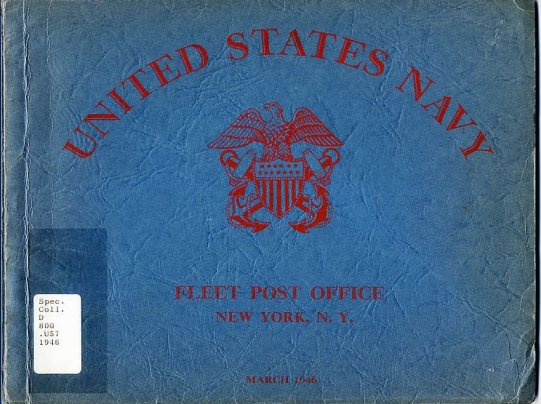
FORWARD
For those who served aboard at the Fleet Post Office, New York, their naval careers have already been terminated. For others of us, the close of our service to the Navy lies in the near future.
So that the coming years may not dim, too much, the memories of duty at the Fleet Post Office, New York, during World War II, we present this memento.
May it bring you many moments of pleasant recollections in the years which lie ahead and remind you of the part you played in performing a job -- WELL DONE!
/S/
M. Hegarty
Lt. Cmdr., U.S.N.R.
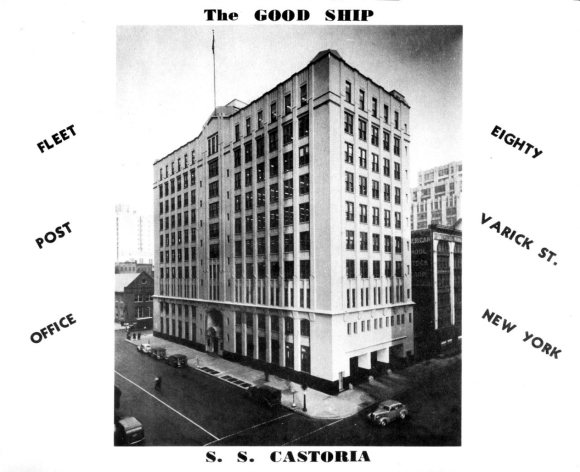
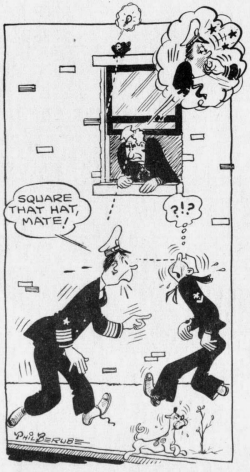
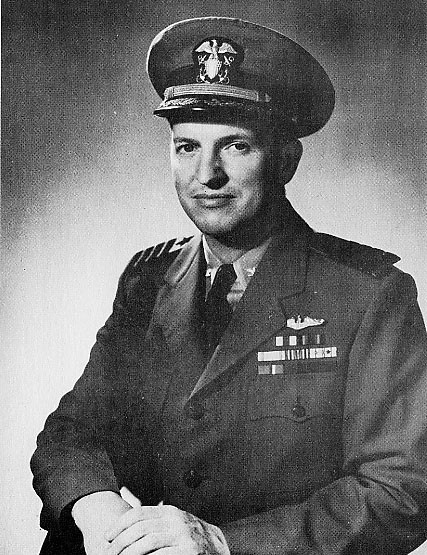
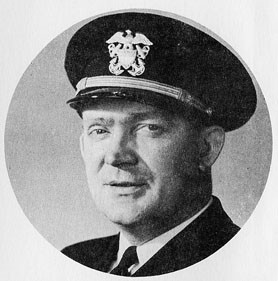
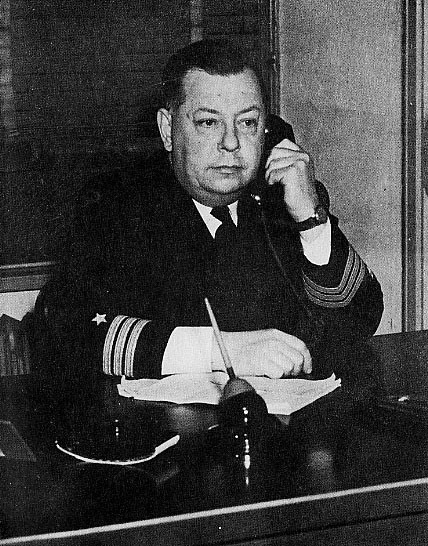
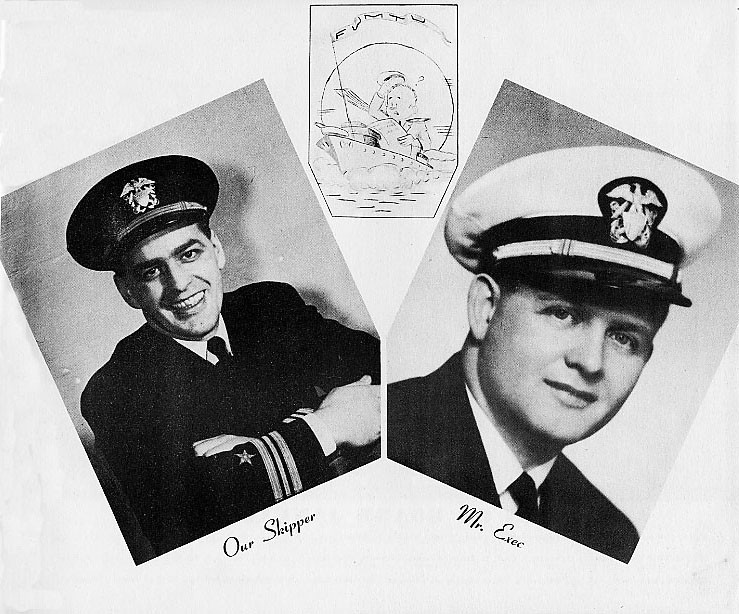
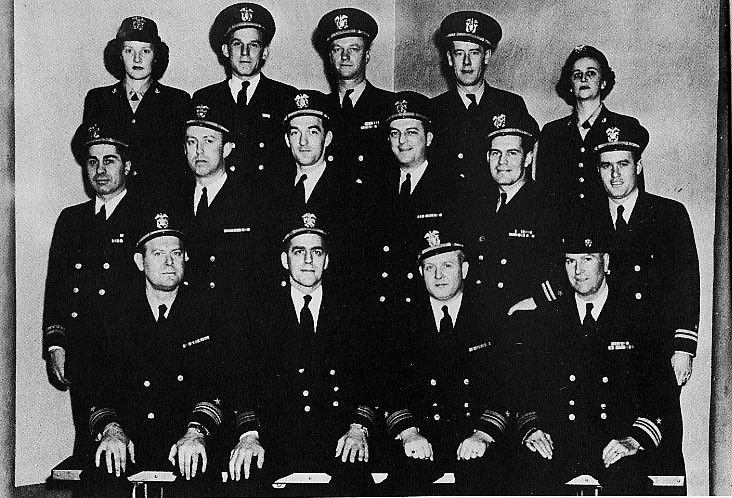
OFFICERS ON BOARD JANUARY 1946
Seated (left to right) - Lt. Cmdr. Barney Koplin, Lt. Cmdr. Willet J. Hegarty, Lt. Cmdr. John J. Lamb, Lt. Cmdr. George A. Bergen.
Second Row (left to right) - Lt. Armand F. Cirilli, Lt. Robert L. Decker, [Lt.] William W. Woodbridge, Jr. [sic, no rank], Lt. John L. Sullivan, Lt. Bun B. Bray, Jr., Lt. Robert B. Fisher.
Top Row (left to right) - Lt. (j.g.) Margaret H. Duff, Lt. (j.g.) Mark J. Burns, Lt. (j.g.) Lester B. Bast, Lt. (j.g.) Daniel M. McDevitt, Lt. (j.g.) Marrie J. Courtois.
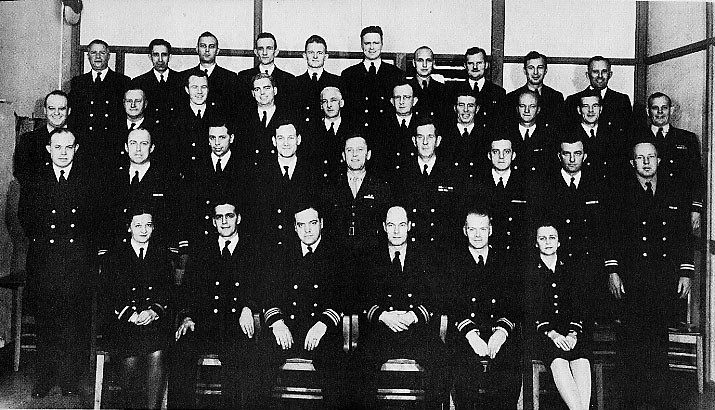
OFFICERS ON BOARD OCTOBER 1944
Seated (left to right): Ensign Charlotte S. Iliescu, Lt. Willet J. Hegarty, Lt. Comdr. Andrew E. Newton, Lt. Jack G. Nussbaum, Lt. Richard C. Gifford, Ensign Marrie J. Courtois.
Second Row (left to right): Lt. (j.g.) Isaac C. Behage, Lt. (j.g.) Robert L. Decker, Lt. Jerome S. Newland, Lt. Lloyd D. Gull, CWO Michael L. Heinrichs, USMC, Lt. (j.g.) James R. Hoag, Lt. (j.g.) Bernard A. Kenner, Lt. Edward F. O'Day, Lt. (j.g.) William L. Dawson, Jr.
Third Row (left to right): Lt. (j.g.) Sidney Ritt, Lt. (j.g.) Charles Dearden, Ensign Surrell A. Hukill, Lt. (j.g.) Alan F. O'Farrell, Lt. (j.g.) Delbart Harris, Lt. (j.g.) John F. Warfield, Lt. Ernest F. Gaskins, Ensign Lester G. Bast, Ensign John D. Heaney, Lt. (j.g.) Gephart T. Stiles.
Top Row (left to right): Lt. (j.g.) Edgar O. Kern, Ensign Alipio M. Santiago, Ensign Horace A. Byrd, Ensign Jack E. Triplett, Lt. William A. Sawyer, Ensign Paul M. Hodges, Ensign Marion J. Pritchard, Lt. (j.g.) Lewis A. Rodwell, Ensign Wilbert C. Trautwein, Ensign James M. Seeley.
THE ANNALS OF F.P.O. NEW YORK
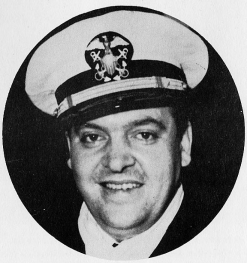
by Lt. John L. Sullivan, U.S.N.R.
The Fleet Post Office was originally established as a naval activity at 80 Varick Street, New York, on 1 July 1943. Prior to that date, mail addressed to naval personnel serving overseas and afloat was handled by Navy mailmen at the Morgan Annex of the New York General Post Office.
The building, formerly occupied by a manufacturing concern, left much to be desired in its use as office space and as a Post Office. At that time, Lt. A. E. Newton assumed the duties of officer in charge and under his direction there began a series of renovations, alterations and additions which transformed all quarters into their present clean, well lighted condition, and brought about a pleasant atmosphere generally. A Ship's Service was opened for the convenience of all hands; a recreational area was set aside and equipped with ping-pong tables; an officer's wardroom was constructed and these were only a few of the large number of improvements made.
The first sections to occupy the quarters at 80 Varick Street were the Atlantic Fleet Records Office, the Air Mail Section and the V-Mail Laboratory and Section. Other departments moved from the Morgan Annex as quickly as space was made ready for them.
As more and more naval personnel shipped out to carry on the campaign in the Mediterranean and to build up forces in the preparations for the invasion of "Fortress Europe", the volume of mail handled through the Fleet Post Office increased by leaps and bounds. In order to expedite the handling of such vast quantities of mail, there followed a corresponding increase in the number of personnel on board.
As forces in the European Theater grew larger and larger, it was found that the space available at 80 Varick Street, which had seemed entirely adequate but a short time previously, was being rapidly utilized to capacity. Anticipating an avalanche of parcels for the 'Christmas Rush', space was acquired on Pier 51, North River, and the Parcel Post Section was moved to that location in September, 1944. The avalanche of parcels did materialize and, it might be added, was dispatched within record time and without a hitch.
In April 1945, Lt. Comdr. Newton was detached from duty at the Fleet Post Office and ordered to the Pacific for duty on the staff of the Commander Service Force Pacific Fleet. He was succeeded by the Executive Officer Lt. W. J. Hegarty. Upon assuming the increased responsibilities and duties of Officer in Charge, Mr. Hegarty was advanced to the rank of Lieutenant Commander. Lieutenant John J. Lamb, after completing a tour of duty in the South Pacific and Western Carolines, took up the duties of executive officer.
Shortly after the termination of the European war there began a steady decline in the volume of mail passing through the New York Fleet Post Office. This decrease was reflected in the personnel on board as large drafts of mailmen ratings and a considerable number of officers departed for duty on the West Coast and in the Pacific Areas. The collapse of Japan in August, 1945, brought about a still further decrease in the operations of the Fleet Post Office.
Soon thereafter, plans were taken under consideration looking towards the return of the Fleet Post Office functions to the General Post Office. During December 1945, the transfer of the operations of several sections was effected. Pending developments of the Christmas volume, however, the Fleet Post Office remained substantially intact. January 1946 brought a large scale return of functions to the General Post Office. Among the sections transferred were First Class, Air Mail, Registry and Parcel Post. As rapidly as conditions allow, other sections will be transferred or eliminated.
And so, in the near future, all remaining personnel will pass down the gangway for the last time and, with a salute and feeling of nostalgia, say "Happy Sailing" to the good ship S. S. Castoria - A GRAND OLD GIRL.
_____________________________
Most of the following pictures of the various sections were taken during January 1946 by Paul Del Nero, when the personnel on board was being rapidly reduced through discharges and transfers. It is regretted that many pictures taken when the Fleet Post Office was at its peak of activity proved to be unsuitable. The majority of these pictures were of large groups and it was impossible to reduce them to the proper size so that they could be included herein.
_____________________________
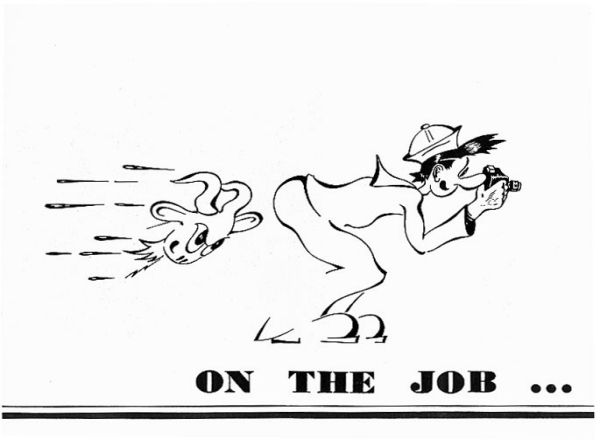
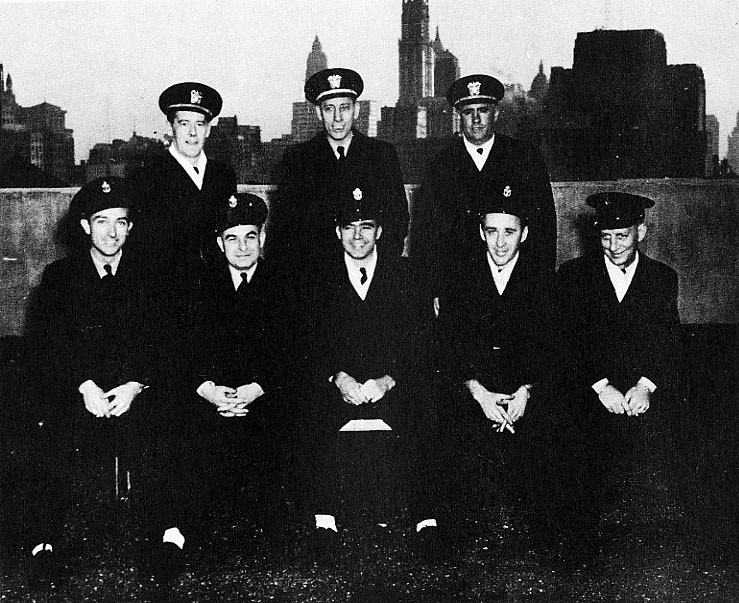
FIRST CLASS AND AIR MAIL SECTION
First Class and Air Mail, the "bread and butter" of the United States Post Office Department, also remained the main item in the Navy Mail Department.
Originally consolidated into one section, this department had its beginning at the Morgan Street Annex of the New York Post Office with a complement of six men and a petty officer first class in charge. Their average volume of mail amounted to twelve pouches of First Class and two pouches of Air Mail daily. But as the Navy grew, so did the First Class and Air Mail Section.
Upon establishing new quarters at 80 Varick Street, the volume of Navy mail grew to such proportions, it was necessary to separate the section into two parts, and add as many as 297 persons to the complementary personnel. The volume of First Class grew to a daily high of 634 pouches which amounts to 793,750 pieces, and Air Mail grew to a daily high of 449 pouches or 673,500 pieces.
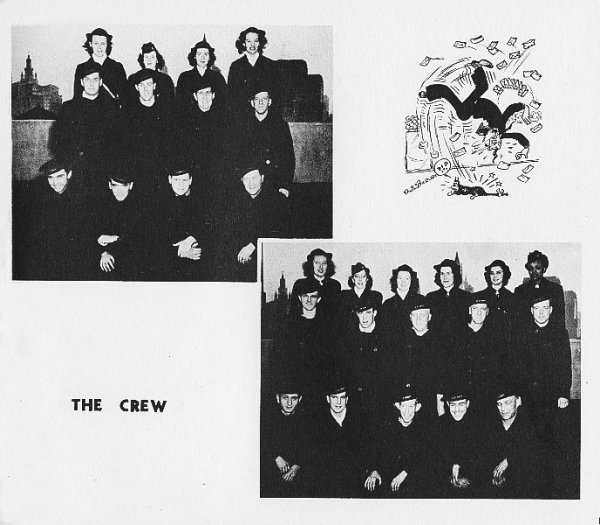
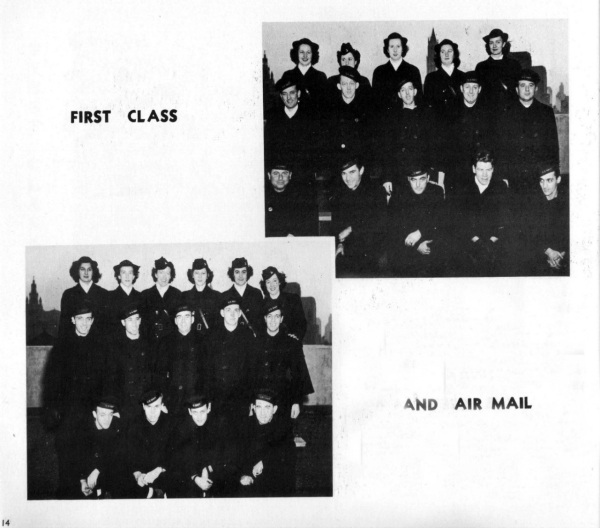
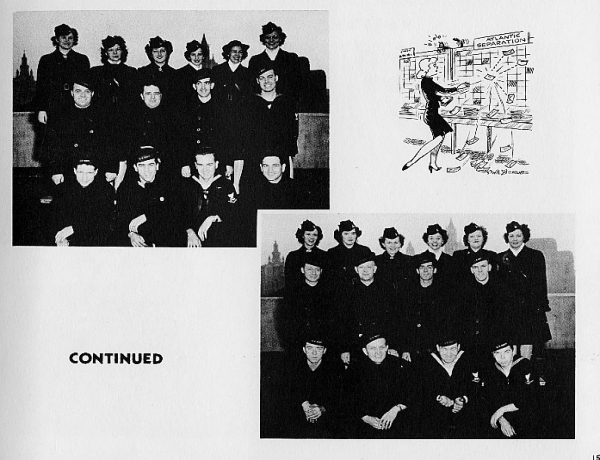
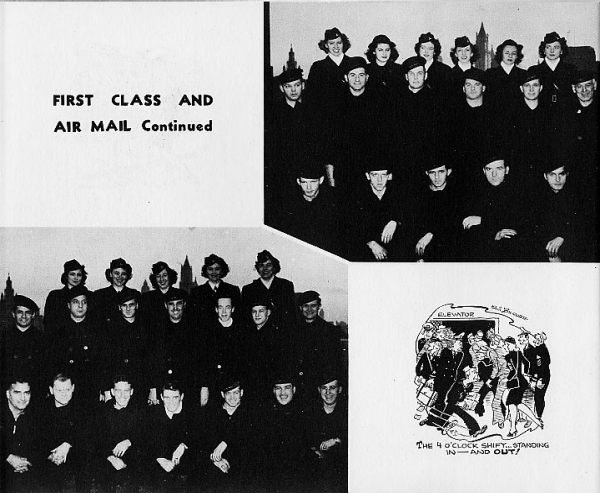
PERSONNEL SECTION
The Administration Deck, known at the activity as the Personnel Section, is where the offices of the F.P.O. officials are to be found. With Lt. Cmdr. W. J. Hegarty as skipper of the ship, and Executive Officer, Lt. Cmdr. J. J. Lamb, second in command, the seventh deck is the nerve center of the New York Fleet Post Office.
Organized in December 1943 when the service records were received from the Third Naval District Headquarters, Lt. (j.g.) D. J. Harris (then Warrant Ship's Clerk) was the first Personnel Officer. In December 1944 he was succeeded by Lt. E. F. Gaskins and one year later by Lt. R. L. Decker
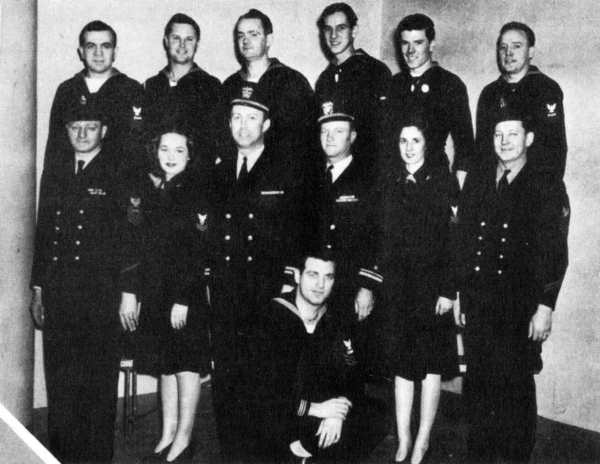
From a small beginning of a handful of Waves, the Personnel Section grew to an organized office force of 50 trained yeomen in less than a year. Through their hands have passed the records of almost 5,000 MaM's with a peak standing complement of over 2,000 in Ship's Company.
Unexperienced in mass-transfer, the personnel got its first work-out in the latter part of '44 when the ComServLant Pool, with 100 men, was formed. From that time on until June 1945, the turnover was terrific, with the largest draft being the AFRO departure to San Fran that month.
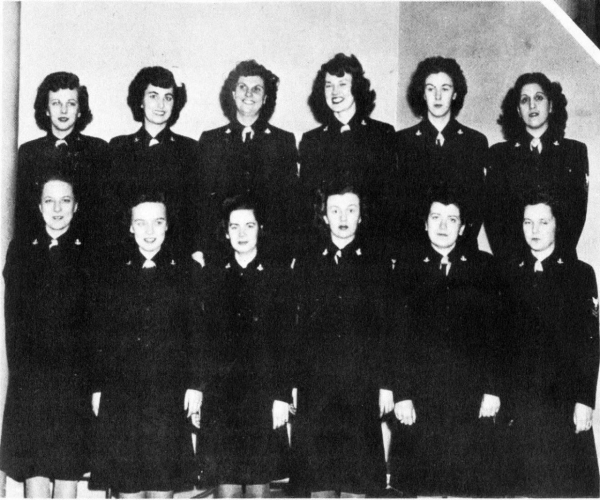
MERCHANT MARINE SECTION
From the time of its establishment in November 1943, until the General Post Office reassumed the handling of current mail in December 1945, this section maintained 24-hour, 7-day service for the crews of Merchant, Army Transport and Army Hospital Ships. The primary function, at present, is to dispatch mail, which, for various reasons, failed to reach ships on dispatches prior to December 1st. When this function is completed, the Fleet Pony's "Obituary' will be official.
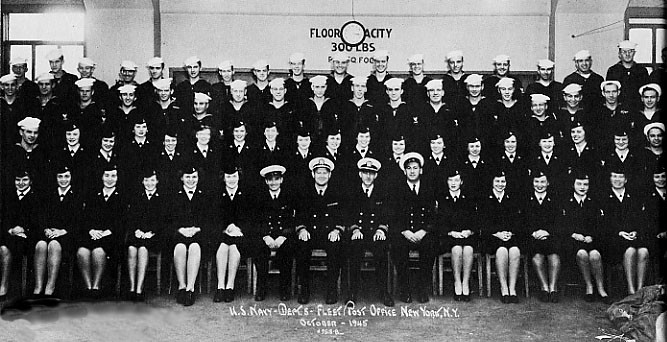
Despite the "Obituary" which appeared in the November 1945 edition of the Fleet Pony, the Merchant Marine Section is still alive and functioning. True, the volume of mail being handled is a far cry from the approximately 350 pouches of First Class mail, 2,000 sacks of Parcel Post and 1,000 sacks of prints which were received and dispatched monthly during the first 25 months of its existence, but the personnel has been cut proportionately from the then average complement of one officer and seventy-five enlisted men and Waves.
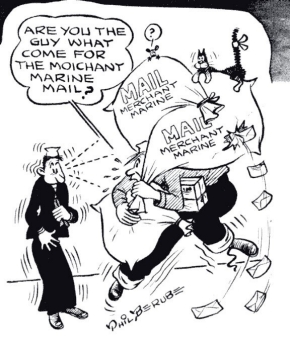
LOCATOR SECTION
During the war, some twenty-two thousand (22,000) United States Navy Units -- from crash boats to carriers -- were shifted 'round the world from Canarsie to Constantinople, from Malaya to Murmansk and back again. The Fleet Post Offices were required to know not only where the units were at any given moment, but where they would be at a nebulous future date on which mail could be delivered to them. Like the gunner or torpedoman who 'leads' his target by firing ahead of the moving object, the Locator Section was required to 'lead' the ships, firing the mail at the next post of call. During the SECRET days, information on the deployment of every task force, fleet and flotilla was available in the Locator's monkey-cage; and, with the aide of a modified 'numbers' game, it was possible to tell all hands where to pitch mail, without telling them the whereabouts of the units.
Since V-J day and the relaxation of security, the Locators have been permitted to divulge the location of most Navy units; and this section will be retained as a permanent peacetime function of the postwar Fleet Post Office, to provide routing instructions to the Government Post Office System, with the additional duty of advising the girls from Brooklyn where to send urgent telegrams to their boys in blue.
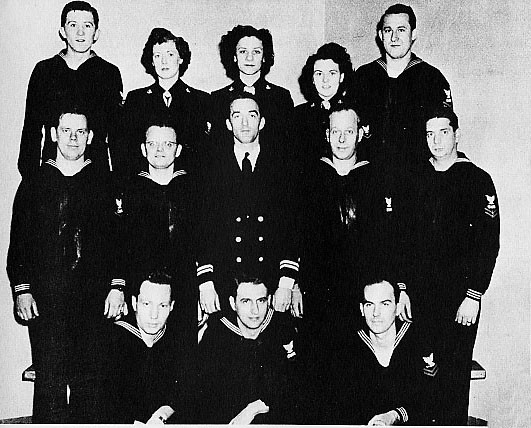
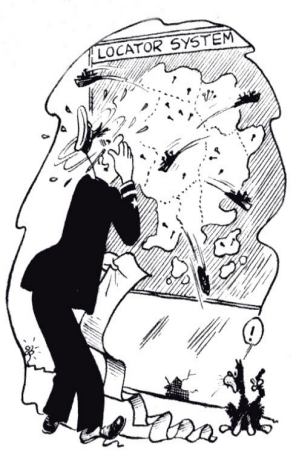
PARCEL POST
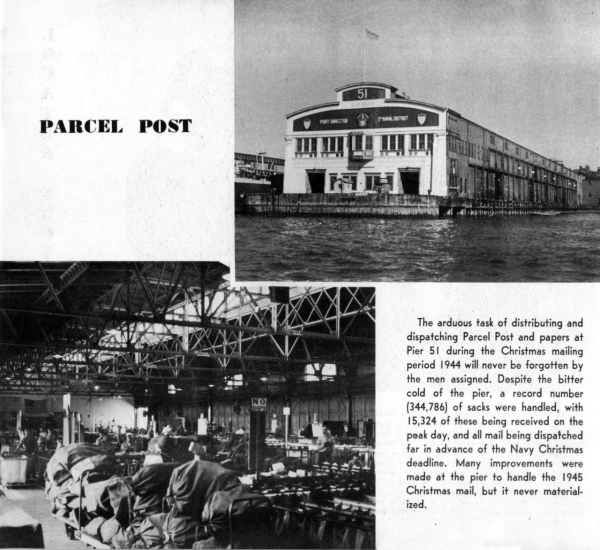
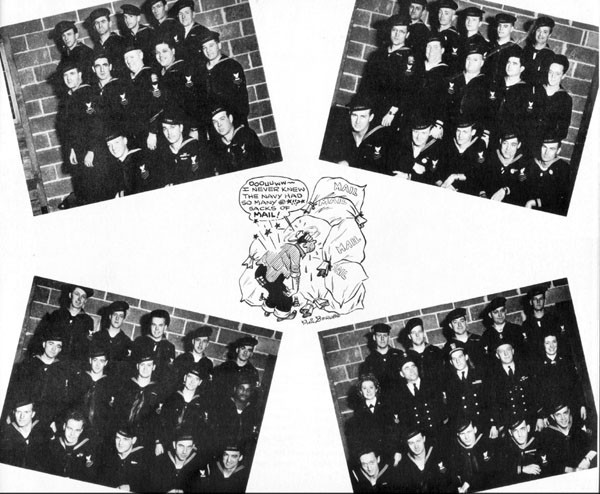
ATLANTIC FLEET RECORDS OFFICE
The Atlantic Fleet Records Office was established 1 July 1943 for the purpose of expediting delivery of mail which had been undeliverable as addressed, due in the main to the many changes in stations and billets of personnel during the rapid expansion of the Navy. Ensign I. W. O'Neill was assigned Officer in Charge.
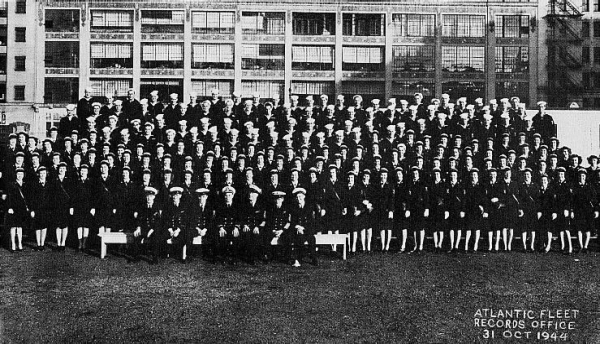
Beginning with fewer than 50 people AFRO grew to a complement of over 300 - the largest single department in the Fleet Post Office. Maintaining an active file of over two and one-half million cards for all naval personnel located in the Eastern half of the United States and European waters, they utilized muster rolls, rosters of officers, reports of changes and change of address cards to keep their cards current at all times. With the aid of these directory cards, hundreds of thousands of pieces of mail were worked weekly. This meant mail for servicemen in the far corners of the world would be received several weeks earlier than might otherwise be the case.
With the cessation of hostilities in the European Theatre, the Navy Department combined the Atlantic Fleet Records Office with the Fleet Records Office of San Francisco to be known as The United States Fleet Records Office. This consolidation was brought about in June 1945. As part of the consolidation, over two hundred AFRO personnel were sent to San Francisco.
ARMED GUARD SECTION
Now with hostilities ended and Merchant ships disarming, the volume of mail has gradually decreased until now handling of this mail has been returned to the Armed Guard Center, Brooklyn, N.Y.
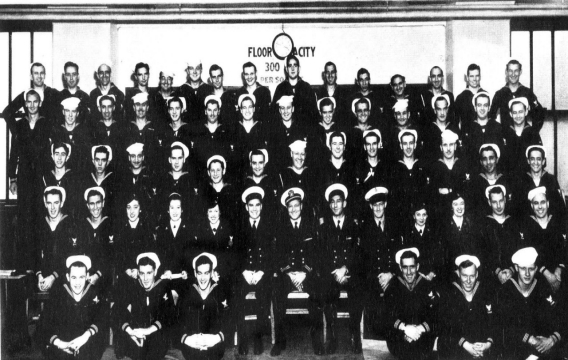
With the rapid expansion of the Merchant Marine, a sub-division had to be made for the Armed Guard crews afloat. At first, this division was established at the Armed Guard Center in Brooklyn, but as the volume of mail increased, it was decided to transfer the section to F. P. O., New York.
Taking over the entire fourth deck, with one end for First Class mail and the other for Parcel Post and Prints the gunners mates hit a peak dispatch of approximately 70 pouches and 120 sacks of mail per day. They wrote their own chits and dispatched mail according to the information received from Washington. However, for security reasons, this was done away with when the "Glass House" was created, limiting the vital movements of ships to a select few.
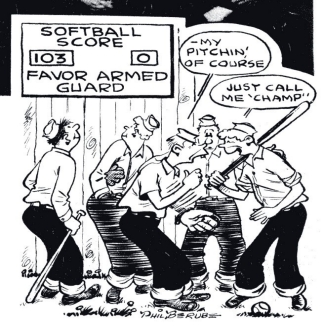
V-Mail SECTION
V-Mail - a World War II innovation of sending a message on a small strip of film, was one of the most widely talked of and advertised mailing methods the Post Office Department has ever sold to the public. However, once the public caught on to the idea, military personnel had to be trained quickly to handle the enormous volume.
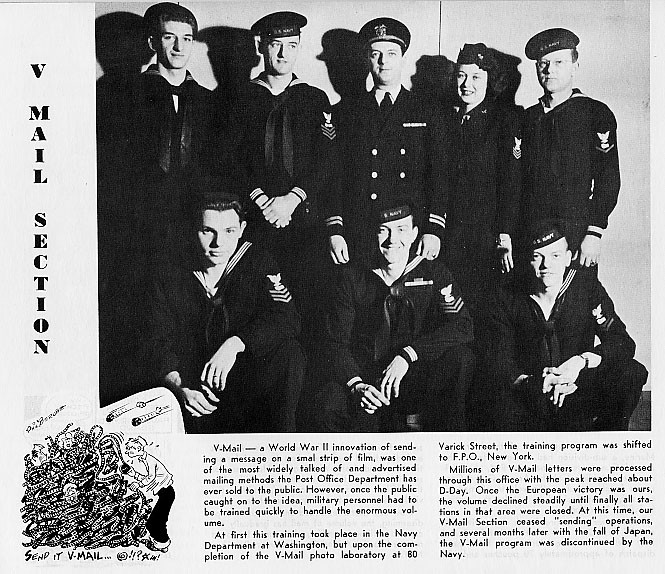
At first this training took place in the Navy Department at Washington, but upon the completion of the V-Mail photo laboratory at 80 Varick Street, the training program was shifted to F.P.O., New York. Millions of V-Mail letters were processed through this office with the peak reached about D-Day. Once the European victory was ours, the volume declined steadily until finally all stations in that area were closed. At this time, our V-Mail Section ceased "sending" operations and several months later with the fall of Japan, the V-Mail program was discontinued by the Navy.
REGISTRY SECTION
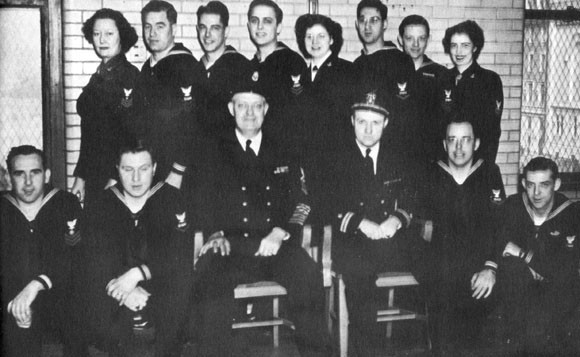
The Registry Section was operated by the Navy Mail Clerk of the New York Fleet Post Office - Chief F. W. Nicholson. It, like most Navy Post Office divisions, also had its beginning at the Morgan Street Annex; and when the Navy unofficially commission-ed the S.S. Castoria to handle Navy mail, the Registry Section made its headquarters on the south end of the seventh deck. Beginning with a small crew of MaM's, which increased to 49 at the peak of the war and decreased to 16 at the time of this writing, all registered mail was given accurate handling to naval personnel throughout the world.
FIRST LIEUTENANT'S OFFICE
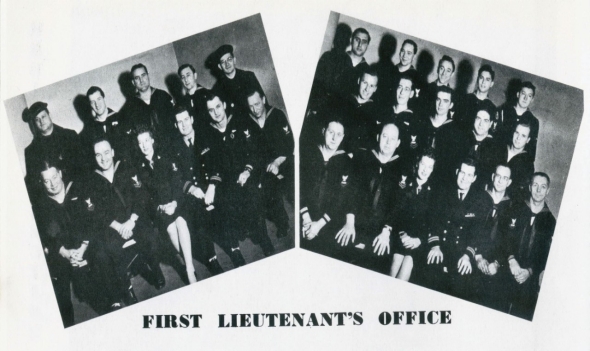
From lead pencils to trucks and tractors has been the assignment of the First Lieutenant's Office, composed of the supply and maintenance sections. It was the task of the supply section to get all the necessary materials and gear to operate the activity. To the men of this section fell the responsibility of maintaining continuous inventories of all equipment, of rationing scarce items, and of storing or shipping surplus gear.
The maintenance shop, made up of carpenters, painters, electricians, and ship fitters, not only kept the building at 80 Varick Street and Pier 51, North River, in good condition, but were ready at all times to construct a loading platform or paint the skipper's door marker.
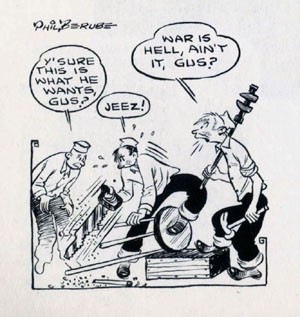
SEAMAN GUARD AND TRANSPORTATION SECTIONS
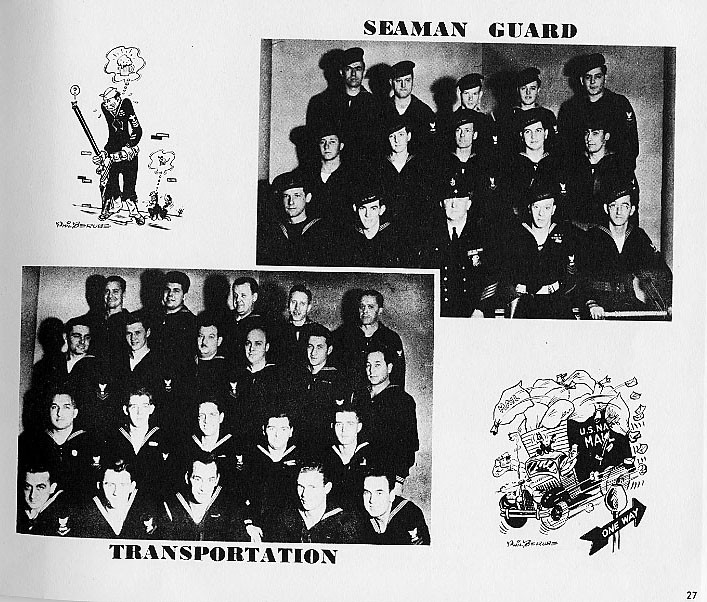
SHIP'S SERVICE
In its embryonic stage, what was later to be the Ship's Service Store, was part of a stamp cage on the seventh deck -"Smiling Sammy" Cohen passing out stamps, personality, wisdom, hot coffee and tooth paste.
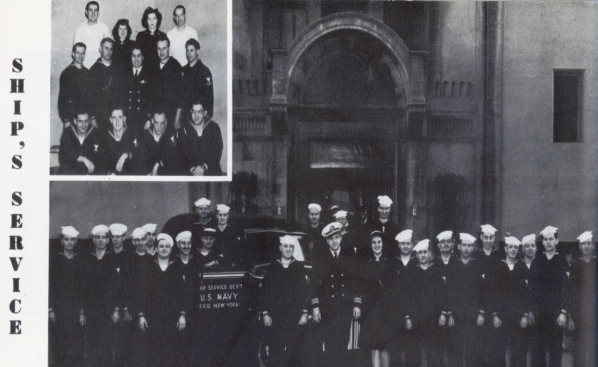
As the Fleet Post Office expanded feverishly, in step with our widening war fronts, new personnel poured into this activity. After much effort, permission was secured to open a Ships Service on the third deck. At the start it was a 'hole in the wall' known as "Charley's Place", after Lt. (j.g.) Charles Dearden, the genial Ship's Service Officer. But the store grew like the proverbial Topsy to a half-million dollar business.
With Parcel Post ensconced at Pier 51, it became necessary prior to the Christmas rush of 1944, to open a Ship's Service Store Annex there. This little store gave much aid and comfort to the personnel in the frigid climate of the North River Pier.
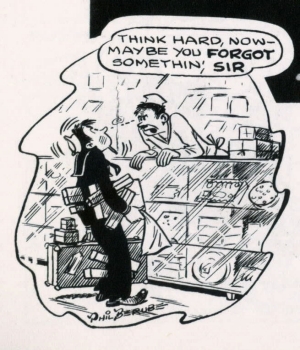
U.S. MARINE CORPS
The Marine Corps has made amphibious landings on almost all decks of the S. S. Castoria. With squeegees a-flying, they took over parts of one deck after another. Casualties remained nil though - even when the personnel diminished from a high of 42 men at Christmas 1944 to a low of 5 in January 1946.
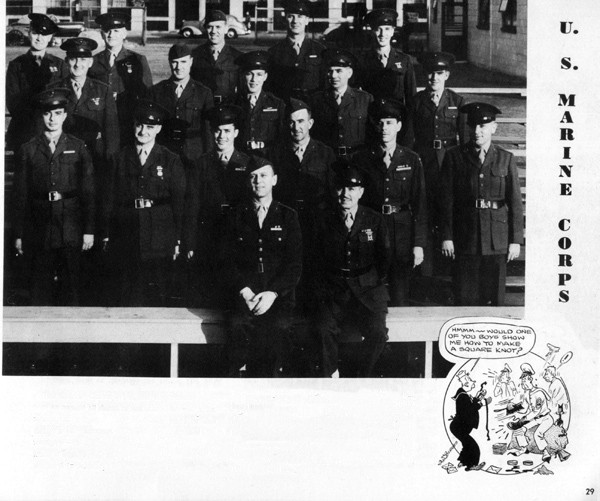
The Marine Corps Section was established at the Morgan Street Annex with C.W.O. Heinrichs in charge. It came to 80 Varick Street in September 1943 with duties similar to Navy Mail separation. In July 1945, C.W.O. Heinrichs was detached and Master Sergeant N. Tushoph took over and remained in charge until the section was returned to the Civilian Post Office 14 January 1946.
THE FLEET POST OFFICE BAND
"The best band in the Third Naval District" was the axiom the Fleet Pony band-masters were proud of.
There was no dispute as to why they received this unofficial title after hearing their versatility of going smoothly from waltzes to polkas and then to boogie-woogie.
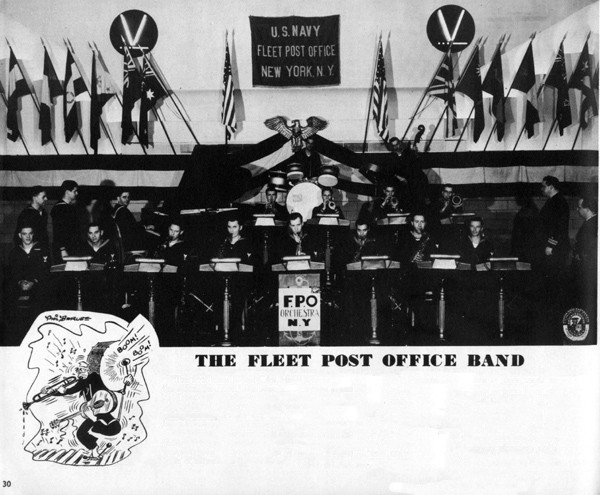
Starting from "scratch" with most members furnishing their own instruments, the boys quickly developed from individualists to a smooth-flowing team of harmonists.
With 203 public appearances to their credit at dances, ships commissionings, ship arrivals, bond rallies, wedding receptions, moonlight sails and many other occasions too numerous to mention, the boys grew so popular that they were in constant demand all over the Third Naval District in addition to playing on their own weekly Saturday afternoon radio program on WMCA.
WELFARE AND RECREATION
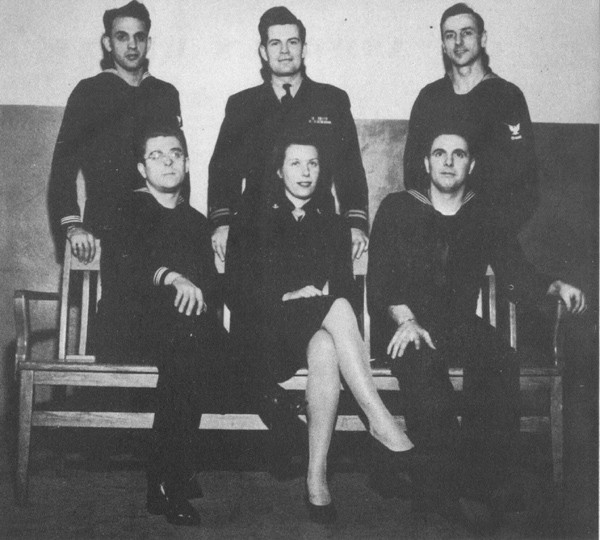
After holding three "final Farewell" dances, the curtain has been rung down on the activities of the Welfare and Recreation department. This was a department organized by Lt. Sidney Ritt and carried on by Lt. Bun B. Bray, Jr. for the well-being of every person stationed at the "fleet". The "fleet" band grew from an activity organization to the best dance orchestra in the Third Naval District. An extensive athletic program was continuously sponsored to get as near as 100% participation as was possible - soft ball leagues, bowling tournaments, a baseball team, a basketball team, and ping-pong tournaments were only a small part of this program. Thousands of dollars were loaned out to personnel for emergency purposes. And, with each new monthly issue, the department's official organ, The Fleet Pony, grew in popularity. Started by John Corrigan with a small mimeograph sheet, the paper grew to a 12-page printed newspaper with Bernie Postreich as editor.
The Welfare and Recreation department found in dances the key to morale uplift for the personnel. As a result, many large dances for all the personnel were sponsored by the department in the leading hotels of the city. In many instances, every item of expense, including tips, was paid by the department. The highlights of the social activities program came with the Harvest Ball on 7 November 1945 at the St. George Hotel and the Christmas dance and Farewell Ball at the Hotel Roosevelt on the 13th of December and 23rd of January respectively.
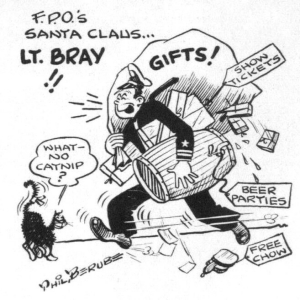
Numerous other activities have been carried out by this department, such as the giving away of gifts, and going-away presents to personnel being shipped to other bases, parties sponsored for orphan children in December 1944 and February 1945, not to overlook the modern ship's library that was installed for Ship's Company personnel.
Thousands of dollars were spent to uplift and maintain the morale of the finest group of gobs and Waves in the United States Navy, but not cent was extracted from Uncle's pocket to procure these means. All funds to carry on this extensive program were derived from Ship's Store profits by our personnel trading there.
THE ADMIRAL'S REVIEW-31 OCTOBER 1944
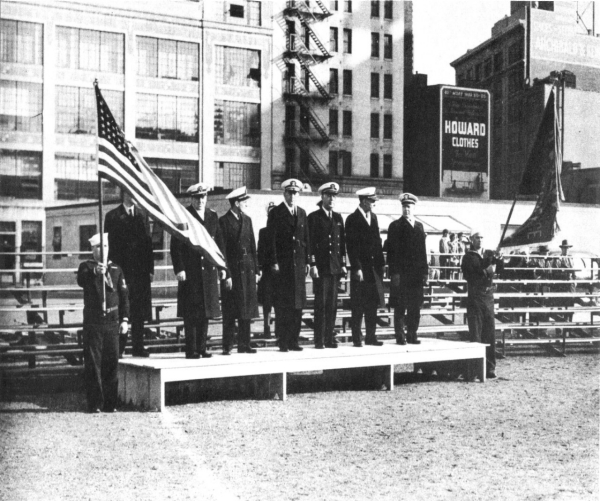
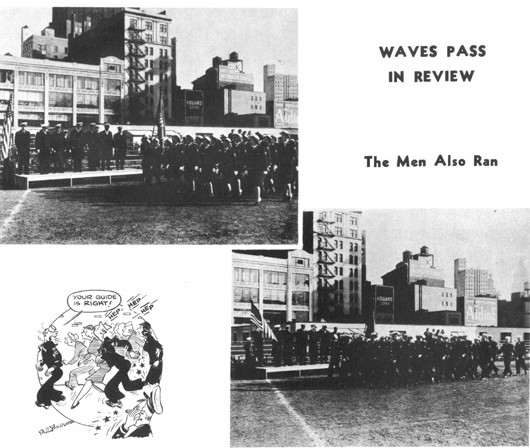
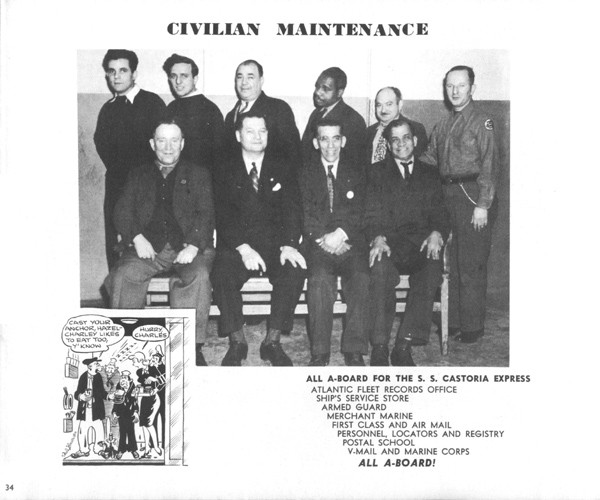
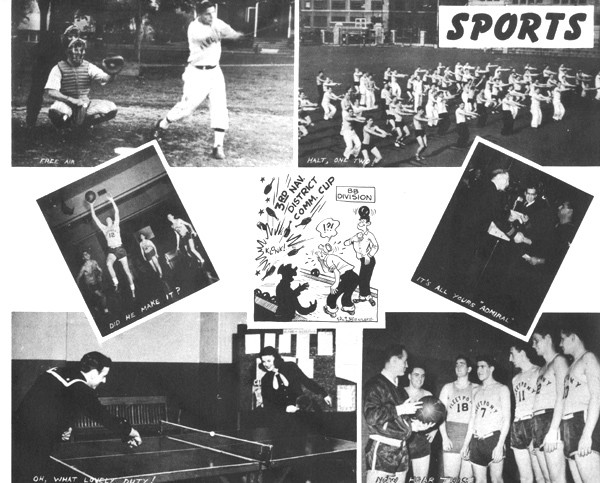
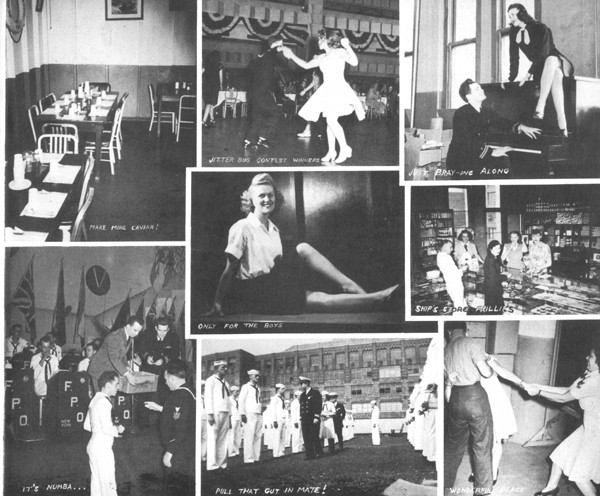
A FINAL WORD FROM OUR
FLEET PONY EDITOR
When things go wrong, as they sometimes will,
When the road you're trudging seems all uphill,
When the funds are low and the debts are high,
And you want to smile, but you have to sigh,
When care is pressing you down a bit -
Rest if you must, but don't just quit.
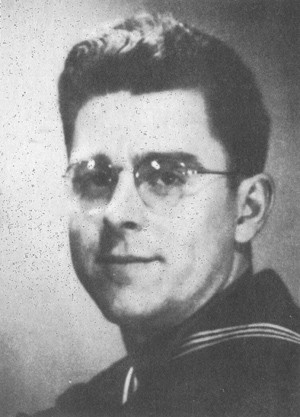
Life is queer with its twists and turns,
As every one of us sometimes learns,
And when many a fellow turns about
When he might have won had he stuck it out;
Don't give up though the pace seems slow -
You may succeed with another blow.
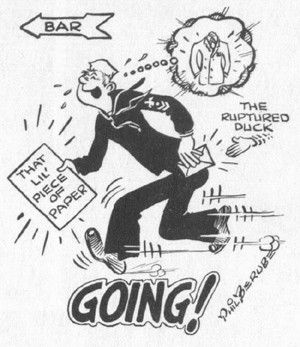
Often the goal is nearer than
It seems a faint and faltering man;
Often the struggler has given up
When he might have captured the victor's cup;
And he learned too late when the night came down,
How close he was to the golden crown.
Success is failure turned inside out -
The silver tint of the clouds of doubt,
And you can never tell how close you are,
It may be near when it seems afar;
So stick to the fight when you're hardest hit -
It's when things seem worst that you mustn't quit.
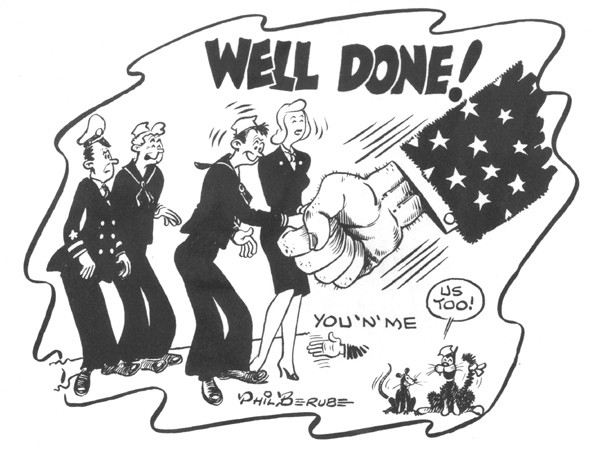
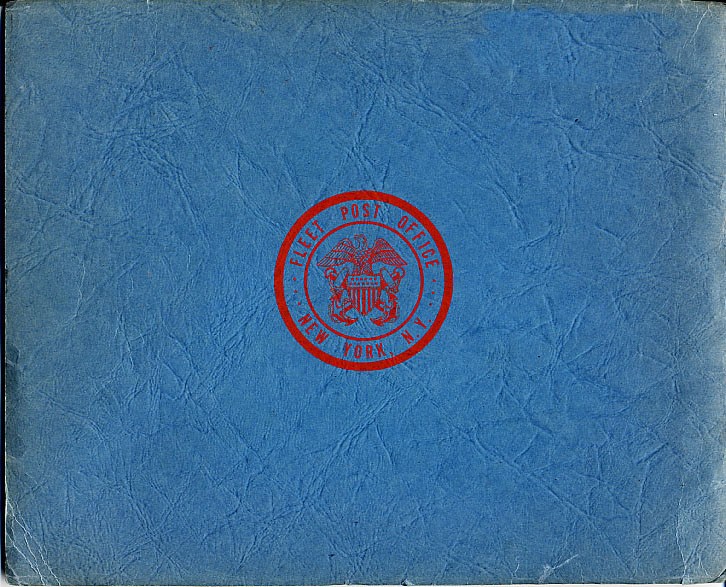
[END]
Footnotes

- Accessibility/Section 508 |
- Employee Login |
- FOIA |
- NHHC IG |
- Privacy |
- Webmaster |
- Navy.mil |
- Navy Recruiting |
- Careers |
- USA.gov |
- USA Jobs
- No Fear Act |
- Site Map |
- This is an official U.S. Navy web site


